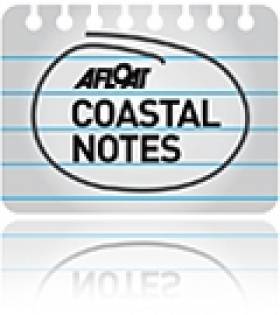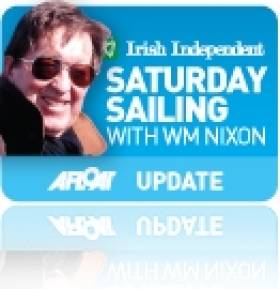Displaying items by tag: Winkie
Afloat's WM Nixon Will Tell Galway Sailors That Irish Were First To Leave Gaff Rig
Afloat.ie’s W M “Winkie” Nixon will be talking the talk at Galway Bay Sailing Club’s mid-week gathering at 8pm on Wednesday, February 1st in the re-vamped clubhouse at Rinville in Oranmore, and all are welcome.
The hospitable GBSC clubhouse is at the heart of one of the main sailing centres on a coastline as much renowned for its association with gaff-rigged traditional craft as it is for being the base for some of Ireland’s most modern offshore racers. But in a wide-ranging profusely-illustrated talk, one of the points Nixon will be making is that it was leading Irish amateur sailors who were in the forefront of the changeover from gaff to Bermudan rig.
Drawing on his extensive experience of sailing both abroad and in Ireland (which he has cruised or raced round more times than he can remember), as a sailing journalist and historian Nixon has discerned significant sailing trends which first emerged in Ireland, but became obscured by major national historical events.
However, he promises that the main theme of his talk – “When Gaffers Weren’t Old” – is the sheer pleasure and fascination of sailing. Admission is free and open to all, but a seaboot at the door will be there to receive €5 from anyone who feels like contributing to the Lifeboats.
Round Ireland Yacht Race – Where Next? What Next?
#roundireland – The biennial Round Ireland Race from Wicklow is the jewel in Ireland's offshore racing crown. It may only have been established as recently as 1980, but now it is a classic, part of the RORC programme, and an event which is very special for those who take part. In fact, for many Irish sailing folk, having at least one completed Round Ireland Race in your sailing CV is regarded as an essential experience for a well-rounded sailing life. Yet despite fleets pushing towards the 60 mark in the 1990s, even before the economic recession had started tobite the Round Ireland numbers were tailing off notwithstanding the injection of RORC support, and the more recent bonus of it carrying the same points weighting as the Fastnet Race itself. At a time when the basic Fastnet Race entry list of 350 boats is filled within six hours of entries opening for confirmation, and when the Middle Sea Race from Malta has confidently soared through the 120 mark, while the 70th Sydney-Hobart Race in seven weeks time will see at least a hundred entries, the Round Ireland Race fleet for 2014 was only 36 boats, of whom just 33 finished. W M NIXON wonders how, if at all, this situation can be improved.
"The Round Ireland Race is the greatest. Why don't more people know about it? Why aren't there at least a hundred top boats turning up every time it starts? It's a marvellous course. We had great sailing and great sport. Can somebody tell me why a genuine international offshore racing classic like this has been going on for 34 years, and yet in 2014 we see an entry of only three dozen boats?"
The speaker isn't just any ten-cents-for-my-opinion waterfront pundit. On the contrary, it's Scotsman Richard Harris, skipper and part-owner with his brother of the potent 1996 Sydney 36 Tanit, the overall winner of the Round Ireland Race 2014. And he's asking these questions as someone who has raced with success in both the Fastnet and Sydney-Hobart Races, and has campaigned his boat at the sharp end of the fleet with the RORC programme from the Solent, and in any worthwhile offshore racing he has managed to find in his home waters of Scotland.
Harris is getting into fine form, as we're at the Tanit table for Wicklow Sailing's Club's Round Ireland Prize-giving Dinner-Dance in the Grand Hotel in Wicklow town last Saturday night. With a boxload of trophies for Tanit to collect, anyone would be in exuberant spirits. But his views on the quality of the Round Ireland Race are clearly thought out and genuinely held, and he is enthusiastically supported by his navigator, Richie Fearon.
Fearon is the man to whom the Tanit crew give the lion's share of the credit for their success, which was achieved by just six minutes from Liam Shanahan's J/109 Ruth from the National YC in Dun Laoghaire. He was the only one in Tanit's crew who had done the race before, and in an all-Clyde lineup, his was the only Irish voice, as he sails from Lough Swilly YC in Donegal. His previous race was in 2010 with the Northern Ireland-based J/124 Bejaysus (Alan Hannon), which finished 7th overall. But for the Derry man, second time round made the course if anything even more interesting.
"You get a wonderful sense of the race progressing all the time, of moving along the course" says Fearon. "In the Fastnet, for instance, there are periods when you feel as though you're sailing in a sort of limbo. But in the Round Ireland, you're always shaping your course with the next rock or island or headland or wind change or tidal time in mind. There's a fascinating and challenging mix of strategy and tactics and navigation and pilotage, all of which results in one of the most interesting distance races in the world. They really should get more people to do it. It gives a wonderful feeling of achievement and completeness when you just finish the course. And it's even better if you do well, as we felt we'd done in 2010. But believe me, winning overall, and in a boat as interesting as this with a crew of guys as good and as friendly as this, that's the best of all!"
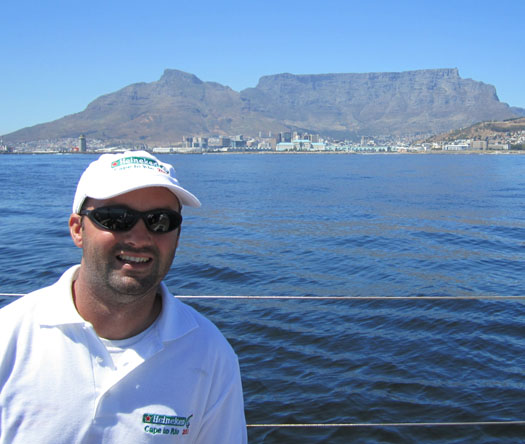
Richie Fearon of Lough Swilly YC, seen here kitted up off Cape Town for the Transatlantic race to Rio, navigated Tanit to the overall victory in the Round Ireland 2014
So how do you explain to such people, people who have become Round Ireland enthusiasts with all the zeal of recent converts, just why it is that Ireland's premier offshore event can barely attract a viable quorum when the yacht harbours of Europe are bursting with high-powered offshore racing boats which are constantly on the lookout for events worthy of their attention, not to mention commercial offshore racing schools and training programmes which need events like the Round Ireland Race to stay modestly in business?
How indeed, when we already have enough difficulty in explaining it all to ourselves. Inevitably, we have to look at the history, and the setting of that history. The last time I was at the Round Ireland Prize-Giving Dinner-Dance in Wicklow, there'd been enough participants from my home port of Howth in that year's race to make it worthwhile for us to hire a bus to go down through the Garden County for the party. We were in the midst of the Celtic Tiger years when people's expectations were becoming very pretentious, and I remember two foodies seated nearby in the bus pompously hoping to high heaven that the evening's meal wouldn't be the inevitable rural feast of beef or salmon.
But the charm of Wicklow town is that, though it's barely a forty minute drive from the capital, it is very much of the country - l'Irlande profonde as you might say. 'Tis far you are from big city notions of fancy menus to appeal to jaded metropolitan taste-buds. So it was indeed beef or salmon. Not that it really mattered that much to the crowd on the bus from Howth. They were well fuelled with on-board liquor by the time we got there, and the return journey in the small hours was made even longer by the need for frequent comfort stops, thus all they'd needed in the meal was absorbent food to mop up the booze.
Some things have changed greatly in the past few years, not least that there was so little Howth involvement in 2014's race that one very modest car would have done to get all the participants to last Saturday night's prize-giving dinner dance in Wicklow. But some things, thank goodness, don't change. It was still beef or salmon. And very good it was too, as salmon is excellent fish if you don't try to pretend that it's steak and grill it. That brings out its least attractive taste elements. But a baked darne of salmon with a well-judged sauce, such as we had last Saturday night, is a feast for a king. And I gathered the roast beef was very good too.
But it all reinforced the feeling that we were in the biggest hotel – the only hotel? - in a small Irish country town. Yet apart from the sailors at the night's event, there was nothing to suggest that Wicklow is a port, for there's something about the layout of the place which makes the harbour waterfront wellnigh invisible unless you seek it out. It's a delightful surprise when you do find it, but it's very much a little working port, rather than a natural focus for recreational boating and the biennial staging of one of the majorevents in the Irish sailing calendar.

You almost have to take to the air to see that Wicklow is a little port town, for as this photo reveals, the main street turns its back very decisively on the workaday harbour in the Vartry River.
It was back in 1980 that Michael Jones of Wicklow Sailing Club took up boating magazine publisher Norman Barry's challenge for some Irish boat or sailing club, any maritime-minded club at all, to stage a round Ireland race. Jones went for the idea, and Wicklow have been running it every other year ever since. It may be the jewel in Irish offshore sailing's crown. But in Wicklow's little sailing club, it is the entire crown, and just about everything else in the club's jewel and regalia box as well.
Whether or not this is good for the general development of sailing in Wicklow is a moot point, but that's neither here nor there for the moment. What matters is that as far as the growth and development of the Round Ireland Race is concerned, in the early days of the 1980s the fact that Wicklow was a basic little commercial and fishing port with only the most rudimentary berthing facilities for recreational boating didn't really matter all that much, as most other harbours in Ireland were no better.
In 1982, the great Denis Doyle of Cork decided to give the race his full support with his almost-new Frers 51 Moonduster. Denis was someone who strongly supported local rights and legitimate claims, and he reckoned that the fact that Wicklow Sailing Club had filled the Round Ireland Race void, when larger longer-established clubs of national standing had failed to step up to the plate, was something which should be properly respected. So in his many subsequent participations in the Round Ireland Race, Moonduster would arrive into Wicklow several days in advance of the start, she would be given an inner harbour quayside berth of honour in a place as tidy as it could be made in a port which seems to specialise in messy cargoes, and Denis and his wife Mary would take up residence in a nearby B & B and become Honorary Citizens of the town until each race was started and well on its way.
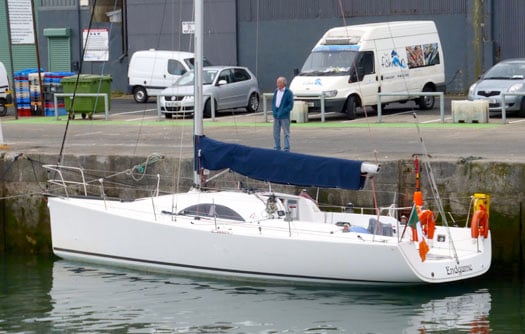
Like father, like son. Denis Doyle's son Frank's A35 Endgame from Crosshaven berthed in Wicklow waiting for the start of the Round Ireland Race 2014, in which she placed fourth overall and was a member of the winning team for the Kinsale YC Trophy. Photo: W M Nixon
It was an attitude which they brought to every venue where Moonduster was raced. The Doyles believed passionately that boosting the local economy should be something that ought to be a priority in any major sailing happening, wherever it might be staged. Denis had been doing the biennial Fastnet regularly for many years before he took up the Round Ireland race as well, and for a longtime beforehand he and Mary had also had the Honorary Citizen status in Cowes, as he would make a job of doing Cowes Week beforehand, living in digs in the town, while at race's end in Plymouth, there'd be a local commitment as well, albeit on a smaller scale.
This was all very well for Wicklow and the Round Ireland in the circumstance of the 1980s, but by the 1990s other ports were developing marinas and providing convenient facilities, yet Wicklow stubbornly stayed its own friendly but inconvenient self. When we look at the geography of the harbour, we can see why, and see all sorts of things that might have been done differently a very long time go.
For instance, when the Vikings were first invading and intent on making Wicklow one of their key ports, it could have been developed in a much more useful way if only the native Irish had made them welcome. Can't you just see it? "We'll overlook the rape and pillage for now, lads, these guys represent substantial inward investment". Just so. Had there been that far-sighted attitude, the locals could have invited the men in the longships to come on up the River Vartry, and into the magnificent expanse of the Broad Lough. What a marvellous vision that would have revealed. With some minor rock removal and a little bit of dredging in the entrance, it could be a wonderful extensive natural harbour in a beautiful setting. Had that happened, just think how differently the facilities of modern Wicklow harbour might now be.
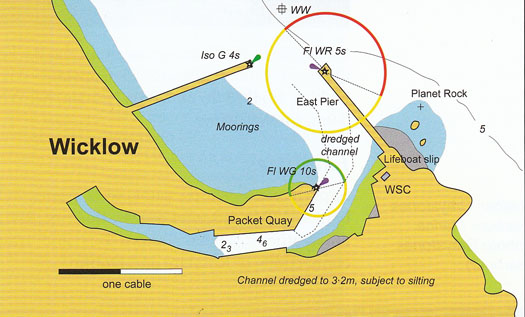
The navigable part of Wicklow Port as it is today. The water does not really come to a sudden straight-line stop as shown on the left – that's just the bridge. Plan courtesy Irish Cruising Club
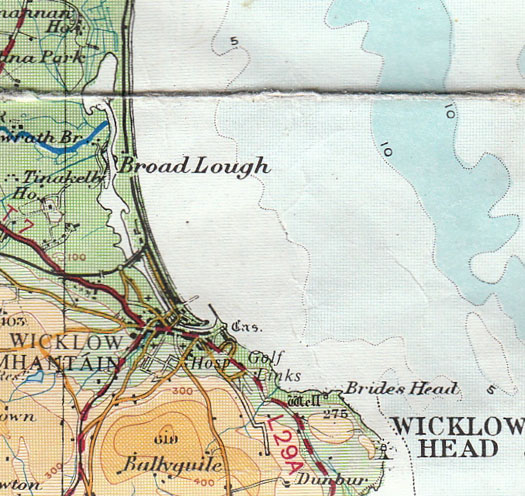
The bigger picture. Had the Vikings not been stopped such that they had to establish their settlement at the mouth of the Vartry River, they might have been able to create a much larger harbour settlement further in around the shores of the Broad Lough, with obvious advantages for Wicklow Port as it might have become today
Instead, the Vikings struggled ashore on the first available landing place at the first bend of the river, and established a beach-head which became such a successful little fort that eventually they were able to burn their boats. But by thattime, they were totally committed to having Wicklow town in its present cramped location. Access to the Broad Lough at high water (there's a very modest tidal range tidal) was soon restricted by the bridge, and then other river crossings, such that today nobody thinks of it as a potential harbour at all, if they ever did.
But meanwhile the current inner harbour is a cramped and dirty river which seems to be ignored by the town as much as possible, such that even the Bridge Tavern, the birthplace of Wicklow's most famous seafarer, Captain Robert Halpin of SS Great Eastern and trans-oceanic cable laying fame, turns its back firmly on the port. And as for the outer harbour, while it's a delightful place on a summer's day, it is not a serious proposition for berthing a large fleet of boats preparing for a major 704-mile offshore race, but people have to make do with it as best they can.
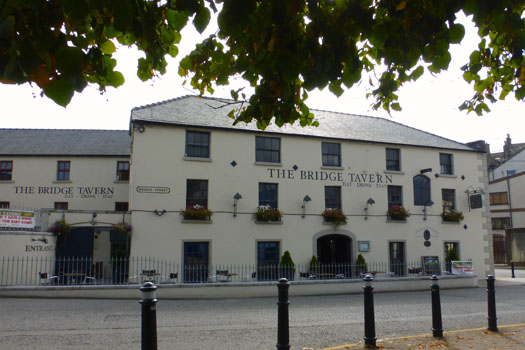
Despite being the birthplace of the most famous Wicklow seafarer, Captain Robert Halpin, the Bridge Tavern turns its back on the harbour. Photo: W M Nixon
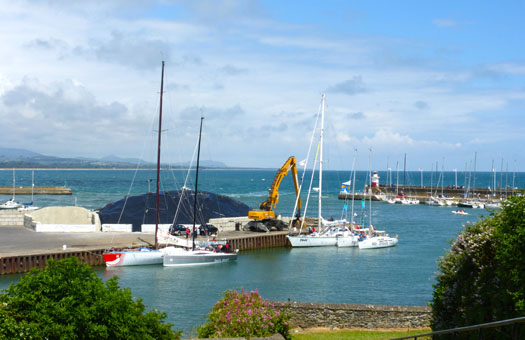
Wicklow's Outer Harbour on the morning of the Round Ireland race 2014 is a lovely sunny spot..............Photo: W M Nixon
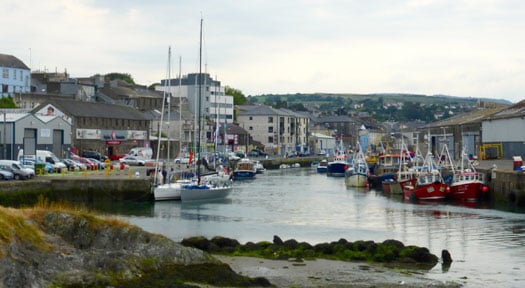
....but it is the inner harbour, shared with fishing and other commercial craft and assorted non-maritime quayside businesses, which will shelter the fleet preparing for the Round Ireland Race. Photo: W M Nixon
It was in the 1990s when the Round Ireland fleet was at its peak that the problems with the harbour's limited facilities were at their most acute, and it may be dormant memories of those difficult conditions which contribute to today's shortage of enthusiasm for the race. Back in the 1990s, the average cruiser-racer was not kitted out as a matter of course to RORC requirements, thus those undergoing their first scrutiny in order to be allowed to race round Ireland had to get to Wicklow several days in advance, and then often spendmoney like water to get up to scratch, the necessary bits and pieces being supplied by chandlers' vans parked on the quay.
It was crazy, not unlike a waterfront version of Ballinasloe Horse Fair - all that was missing was Madame Zara in her shiny caravan giving out nautical horoscopes in sepulchral tones for the wannabe Ireland circumnavigators. Perhaps she was there, but the two times I was going through the process with my own boat, it was so hectic I wouldn't have noticed. All I wanted to do was get to sea and away on the race, and get the filth of Wicklow harbour washed off the boat as soon as possible, as we'd drawn the short straw and had been berthed right in against the quay, so everyone has used our boat as a 35ft doormat on their way across to their own craft.
But the finish of the race at Wicklow – now that was and is completely different. The place seems to have transformed itself while you've been away bashing through sundry waters and a lot of the Atlantic in the intervening five days. Everyone is feeling like a million dollars, and Wicklow seems the only proper place in the whole wide world to finish a major offshore race. And as for the Round Ireland Prize Giving Dinner Dance, the venue of the Grand Hotel and beef or salmon for the meal is all part of the formula, it's central to the mystique of this extraordinary event.
In the days of the big entries with massive sponsorship from Cork Dry Gin, the prize-giving was Dublin-centred even if the race had started and finished in Wicklow. And the big bash in the city would start with a huge reception leading on into a gala dinner (I don't remember much dancing) in a glitzy Dublin hotel. In truth, it seemed a bit remote from little boats making their ways alone or in ones and twos back into Wicklow after the profoundly moving experience of racing right round our home island.
By the time you'd done all that, only others who have done the same could truly share your feelings about the experience. Big parties in anonymous city hotels were not the ideal setting for the Autumnal prize-giving and de-briefing. Thus the contemporary final hassle of getting down to Wicklow for the Round Ireland Dinner on a black November night in a veritable deluge of a downpour could be seen as the last stage of a long weeding-out process.
But once you're into the Grand Hotel and the party is under way, it's magic and the camaraderie really is quite something. Old rivalries and grievances fade away. It is also, to a remarkable extent, a family gathering – the number of family crews involved is surely exceptional. And the tone of it for 2014 is set by the presence of the winner of the KYC Trophy for the best three boat team, for the winners had as their top-placed boat the A35 Endgame, fourth overall and owner-skippered by Frank Doyle RCYC, son of Denis and Mary Doyle.
However, inevitably the status of the race and its future development and expansion is something which just won't go away. Any doubts about its importance were soon dispelled by considering the special guests at the dinner, as they included the President of the Irish Sailing Association David Lovegrove, the Vice Commodore of the Royal Ocean Racing Club Michael Boyd of the RIYC, and the Commodore of the Royal Irish Yacht Club, Jim Horan, whose club in 2014 was for the first time in association with Wicklow Sailing Club on the Round Ireland Race. The RIYC acted as hosting club in Dun Laoghaire for visiting boats which didn't want to go on down to Wicklow until shortly before the start, but wished toavail of modern marina facilities and the amenities of a large sailing port in the meantime.
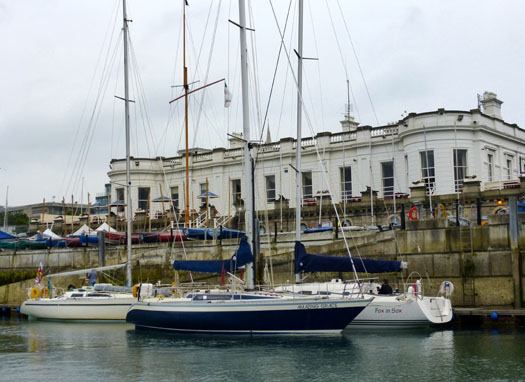
The switched-on crews going to Dun Laoghaire before the start of the Round Ireland Race 2014 knew that the best approach was to make themselves known at the Royal Irish YC and get a berth there, instead of allowing their boats to be banished to the "Siberia" of Dun Laoghaire Marina's remote visitors berths. Photo includes the MG38 McGregor IV from Essex which finished tenth overall (left), and the Oyster 37 Amazing Grace from Kerry, which had been in the frame but was forced to retire with equipment failure. Photo: W M Nixon
It was a partnership with potential, but it will need to be worked on. For although boats from other parts of Ireland knew that on arrival in Dun Laoghaire the secret of being well looked after was to make your number directly with the RIYC, boats from further afield coming into Dublin Bay tended to contact the marina, and thus they were stuck into Dun Laoghaire Marina's absurd visitors' berths, which are right at the very outer end of the pontoons, way out beyond acres of currently empty berths, such that it's said that anyone on them is one whole kilometre's walk from dry land.
Before the Round Ireland Race, the eventual winner Tanit was brought up from the Solent to Dun Laoghaire by a delivery crew who contacted the Marina Office, and she was stuck out in the Siberia of those Visitors Berths. It did mean that when she was first properly seen in Wicklow Harbour on the morning of the race, her impact as clearly an extremely attractive and very sound all round boat was all the greater. But nevertheless, if that is Dun Laoghaire Marina's idea of making visitors welcome, then they need to do something of a reality check, and it was a telling reminder that many Dun Laoghaire and Dublin Bay sailors are so absorbed in their own clearly defined and time-controlled activities afloatthat it leaves them with only limited attention for events outside their own sphere of interest.
As for Dun Laoghaire's general public, is there any interest at all? If the start of the Round Ireland Race was shifted to Dun Laoghaire, as some suggest, do you think the vast majority of the locals would take a blind bit of notice? At least in Wicklow they do make a bit of a fuss on the day of the start, with a community-sponsored fireworks display the night before.
In a final twist, in setting up the new Wicklow-Dun Laoghaire relationship, nobody had thought of the Greystones factor. Most had been unaware that the new Greystones marina is unexpectedly very deep. But such is the case, as I learned on Saturday night from the man from Newstalk. It's one of the reasons it cost the earth to build the little place. But it did mean that, in the buildup to the Round Ireland Race, while two of the deepest boats, the Volvo 70 Monster Project chartered by Wicklow's "Farmer" David Ryan, and the Farr 60 Newstalk, were unwilling to berth in Wicklow itself, they'd only to go a few miles north to find a handy berth in Greystones, where they were still very much in Wicklow county. There, they were the focus of much attention. For as we've discovered at Afloat.ie, if we lead a story #greystones, the level of interest is amazing.
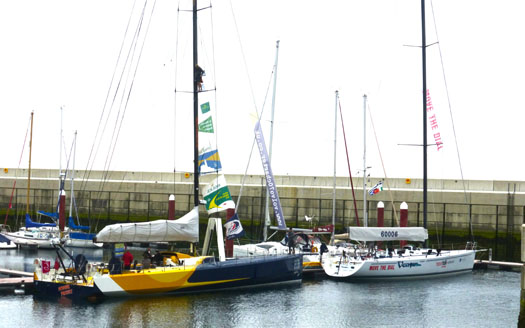
The exceptionally deep water in Greystones Marina provided trouble-free berthing for the Volvo 70 Monster Project and the Farr 60 Newstalk. Photo: W M Nixon
Perhaps after their attendance at the Round Ireland Dinner in Wicklow last Saturdaynight, Tanit's crew now have a better understanding of why the Round Ireland Race is in its present format. And I certainly understand why the level of close personal attention which goes into the race administration by the small team in Wicklow SC running it adds greatly to its appeal for dedicated participants. Before going to Wicklow, I'd been checking with the eternally obliging Sadie Phelan of the race team whether or not Richard Harris would be there, as I had to admit I thought his boat was only gorgeous. "Of course he'll be there" says Sadie, "and I'll put you at his table".
Not only that, but the winner Tanit's table and the runner-up Ruth's table were cheek by jowl, so much so that I was almost sitting at both of them. It would have taken a team of scribes to collate all the information flying back andforth, but everything was of interest.
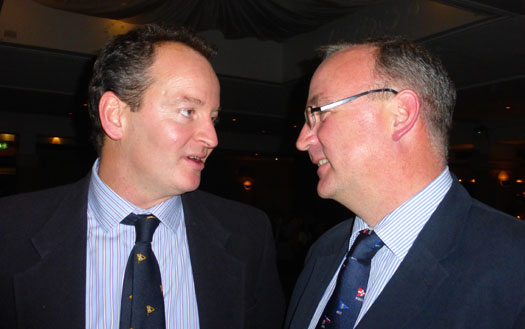
Just six minutes separated them at the end.....winner Richard Richard Harris of Tanit (left) and runner-up Liam Shanahan of Ruth at the Round Ireland prize-giving in Wicklow last Saturday night. Photo: W M Nixon
Richard (42) and his brother have owned Tanit for about twelve years, but as his brother is into gentler forms of sailing, the offshore campaigns are exclusively Richard's territory. In early sailing in the Clyde, they'd campaigned a Sweden 36 with their late father while Richard's own pet boat was a classic International OD. But as his interest in offshore racing grew, heidentified the Australian Murray Burns Dovell-designed Sydney 36 as ideal for their needs. He found there was only one in Europe, a 1996 one, little-used and in the Solent. They soon owned her, and changed her name to Tanit as the family firm is Clyde Leather, a vibrant firm which is the only suede tannery in Scotland.
Thus as raced in the Round Ireland, Tanit had the logo of Clyde Marine Leather on her topsides - a useful sideline is suede products for marine use, including a very nifty range of attractively-priced DIY kits for encasing your stainless-steel steering wheel in suede. Show me a boat which has a bare steel wheel, and I'll show you a boat which is on auto-pilot for an indecent amount of the time. But if you are doing the suede coat thing on your helm, be sure to cover the spokes as well, it makes all the difference for ultimate driver comfort.
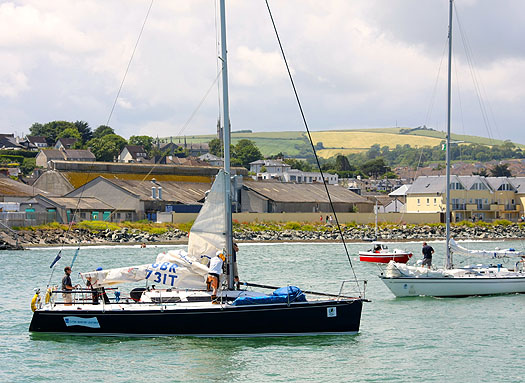
The boat from God knows where....Tanit (left) was an unknown quantity when she made her debut in Wicklow Harbour on the morning of the Round Ireland Race 2014, but father and son crew Derek & Conor Dillon's Dehler 34 Big Deal (right) from Foynes had already taken part in a couple of ISORA races, and went on to win the two-handed division and place 8th overall. Photo: Kevin Tracey
Gradually, they built up Tanit's campaigning in the Clyde, and most of the crew who currently race the boat have been together for seven years. They also chartered a boat to do the Hobart Race of 2008, but as Scottish offshore racing numbers declined, they decided to give it a whirl with the RORC fleets in the English Channel by moving Tanit down there. They found that the programme of concentrated doses of large-fleet intense offshore racing, all taking place at a venue two hours' flight from Glasgow, suited them very well – they could be totally domesticated when at home without the distraction of the boat being just half an hour's drive down the road.
The Sydney 36 of Tanit's type ceased production in 1997, the Sydney 36 you'll tend to come across now on Google is a new 1998 design. So when Tanit's rudder was wrecked after the 2011 Fastnet (a good race for them), it was something of a disaster as a replacement rudder could no longer be supplied off the shelf. It was even more of a disaster for the unfortunate woman who was driving her five-day-old Range Rover around the boatyard in Southampton where Tanit had been hoisted after returning from the Fastnet finish in Plymouth, for not only was her absurdly big shiny new vehicle severely damaged in somehow colliding with the rudder of the Scottish boat, but it turned out that an inevitably custom-built replacement would cost a cool 35K sterling for her insurance company, as that was one very special rudder.
It was a disaster all round, for by the time they'd identified a high tech builder of sufficient repute prepared to build the new rudder, they had missed most of the 2012 season. Then the 2013 Fastnet Race had too much reaching to suit them, as Tanit is at her best upwind and down. So with Richard's brother making louder noises about selling Tanit in order to suit his more sybaritic preferences afloat, the Round Ireland Race 2014 came up on the radar as being an opportunity for what might well be the last hurrah with a much-loved boat.
They needed a navigator, and preferably one with some experience of the Round Ireland course. Fortunately John Highcock of Saturn Sails in Largs, who regularly races with Tanit as one of those ace helmsmen who can seem to smooth the sea, had sailed with Richie Fearon and suggested him with the highest possible recommendation, so the Swilly man was brought on board.
The rest of the crew were complete round Ireland virgins, but they found the race suited their style and level of sailing very well indeed. In any Round Ireland Race, seasoned observers can usually identify beforehand the half dozen or so boats which will be serious contenders for the overall handicap prize, but which one actually wins will depend on the way the chips fall. But Tanit was something of an unknown, a wild card. Yet it wasn't very far into the race before it became clear that this was a good boat on top of her game, if things came right she'd the makings of a winner.

Tanit settling in after the start. The quicker they got south, the sooner they got back into the sunshine........
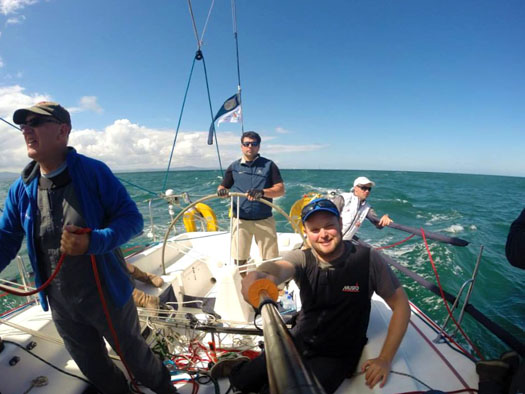
....and nearing the Tuskar Rock on the Saturday evening, they were back in sunshine, and well in contention on the leaderboard.
Within the limits of having a sensible boat which professionals would describe as a comfortable cruiser-racer, they campaign flat out. All meals are built around expeditionary and military Ration Packs, which can be quite expensive to buy in ordinary circumstances, but if you can show they're going to be used for a worthy objective, it's possible to swing a deal, and as Richard's wife Vicky is a physiotherapist who is involved with military reserves, the value of Tanit's campaigns is accepted in the right places. The result is a nourishing supply of reasonably attractive easy-prepare instant food which, as Richard reports still with some wonderment, makes no mess at all in and around the galley, yet keeps the crew on full power.
By the time they got up off the Donegal coast, Tanit was right in there, battling with the defending champion, the Gouy family's Ker 39 Inis Mor, for the overall handicap lead, while up ahead the two biggies, Teng Tools (Enda O'Coineen and Eamonn Crosbie) and the Volvo 70 Monster Project, with David Ryan of Wicklow, kept finding new calms as they tried to shake off the smaller craft.
It was a slow race, but Richie Fearon managed to place Tanit so that she stayed ahead of a calm up in his home waters, and was keeping station on Inis Mor very handily indeed, while the gap with boats astern widened all the time. Or so it seemed. But then the Round Ireland Race pulled one of its regular tricks, and Liam Shanahan and his team on the J/109 Ruth began to shift before they'd even got past Tory Island, and they appeared to carry a useful breeze and a fairtide the whole way from Donegal into the Irish Sea, or at least that's how it looked to the rest of the fleet.
But in closing in over the final stage from Rockabill to Wicklow, navigator Fearon – who was incubating a nasty virus which required antibiotic treatment for a week after the race - convinced Tanit's skipper that they should stay offshore, while Ruth – which seemed to have the race nicely in the bag – followed the Irish habit of hugging the coast. Inis Mor was already finished on Friday morning, but Tanit knew she was beatable by them, and when they came across the line at 1030, it was to move into the CT lead. And going offshore proved to have been their win move.
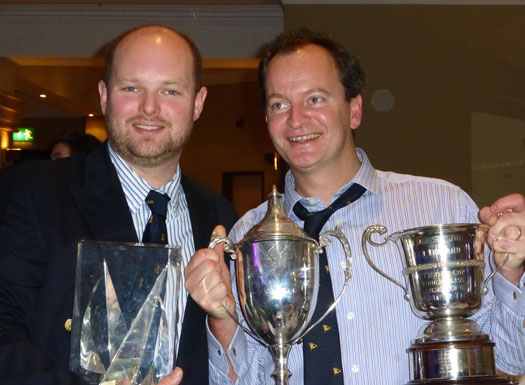
Trophies of the chase – crewman Chris Frize (left) and skipper Richard Harris with some of Tanit's prizes in Wicklow last Saturday night. Photo: W M Nixon
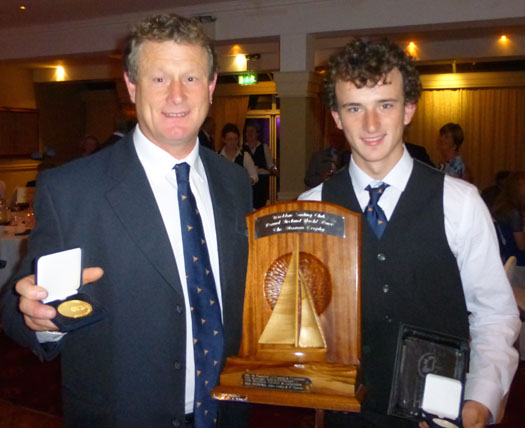
Family effort. Father and son team of Derek and Conor Dillon from Listowel in Kerry (they sail from Foynes) won the two-handed division with their Dehler 34 Big Deal, and placed 8th overall. Photo: W M Nixon
It was a time of screaming frustration for Ruth. She'd been crawling along near Bray Head, barely 15 miles from the finish, as long ago as 0700. She rated only 1.016 to the 1.051 of Tanit. A finish in the middle of lunchtime would do fine. It was so near. It was so far. Finally they got to Wicklow, but Tanit had them beaten by six minutes. Then for the Scottish boat there was just the chance that Ian Hickey's very low-rated veteran Granada 38 Cavatina might do it again. But the wind ran out for her too. Meanwhile Frank Doyle's Endgame came in at mid-afternoon to slot into fourth on CT behind Inis Mor, but Cavatina was fifth, all of five hours corrected astern of Tanit. The Scottish boat was now unbeatable leader.
Tanit's crew for this classic sailing of a true offshore classic was Richard Harris, Richie Fearon, John Highcock, Alan Macleod, Chris Frize, Andy Knowles and Ian Walker. They've a lovely boat of which they're justifiably very fond, but reality has intruded, and now she is indeed for sale. The price is 48K sterling which seems to me very reasonable when you remember that she is remarkably comfortable to sail, that sails and gear have been regularly up-dated, and that we know for certain that the rudder alone is worth 35K.......She's conveniently located for an Irish potential owner, as she's currently ashore in Glasgow. Certainly she has a performance weakness, for as Richard admits, she'll easily get up to 7 knots on a reach, but stubbornly stays there and goes no faster, yet if you harden on to the wind, she'll still be doing 7 knots. But if you go downwind, then whoosh – it's a horizon job on most other boats. Be careful what you wish for, though. With a boat like Tanit in an average fleet, there'll be no excuse for not doing well......
The rest of the trophy placings are here, and on Saturday night they were one lovely compact crowd of people. The family emphasis was inescapable, and it was a particular pleasure to meet the Kerry duo, father and son crew Derek and Conor Dillon from Listowel, who sail out of Foynes in their Dehler 34 Big Deal. In 2015, they plan to take on the two-handed division in the Fastnet, so getting 8th overall and winning the two-handed class in the Round Ireland 2014 was part of a very useful campaign trail.
Finally, as to how to keep the Round Ireland race's distinctive Wicklow flavour while allowing the entry numbers enough room to comfortably expand, it's such a tricky question that it will require a radical solution. A very radical solution. The mistakes of the Vikings must be undone. The Vartry entrance must be dredged, The bridges must all be removed. And the Broad Lough must be tastefully developed to give Wicklow the harbour it deserves, and the Wicklow Round Ireland Race the facilities it needs to cater for a fleet of a hundred and more boats. Simple, really.
ROUND IRELAND RACE TROPHY WINNERS 2014
Line Honours: Denis Doyle Cup - Monster Project (David Ryan, WSC)
IRC Class CK: CK Cup – Monster Project
IRC Class Z: Class Z Cup - Newstalk for Adrenalin (Joe McDonald, NYC)
IRC Class 1: Tuskar Cup – Inis Mor (Laurent Gouy, CBC)
IRC Class 2: Fastnet Cup – Tanit (R Harris, SYC)
IRC Class 3: Skelligs Cup – Ruth (L Shanahan, NYC)
IRC Class 4: Tory Island Cup – Cavatina (I Hickey, RCYC)
Class 5 (Cruiser HF) – Cavatina
Class 6 (pre 1987) Michael Jones Trophy – Cavatina
Class 7 (two-handed) Noonan Trophy – Big Deal (D & C Dillon, FYC)
ICRA Trophy (best Irish boat) - Ruth
Ladies Award: Mizen Head Trophy - Pyxis (Kirsteen Donaldson)
ISORA Award – Ruth
Team Award: Kinsale YC Cup – Endgame (F Doyle), Wild Spirit (P Jackson) & Fujitsu (D B Cattle).
IRC Overall: Norman Barry Trophy – Tanit
Round Ireland Overall: Wicklow Cup - Tanit

Monster boat, monster prizes. Line honours and Class C winner David Ryan of Wicklow, who raced the Volvo 70 Monster Project to success, with Roisin Scanlon, also WSC, who crewed on the Monster during the Round Ireland Race Photo: W M Nixon
Is The New Dublin Bay 24 The Best Way Forward For Old Classic Yachts?
#classicboat – The preservation of old boats can be a contentious issue, particularly so when the vessel is of significant historical interest at several levels, such as Erskine & Molly Childers' ketch Asgard. Technical and academic question arise as to when a refit become a major refurbishment, when does a preservation become a conservation, or when is a restoration veering into being a re-build? Alternatively, should you simply cut your losses and build from new, but using the original plans if the boat meant something very special to you and the larger maritime community? W M Nixon takes a look at three special boats of Irish interest which are currently at an important changes of course in their voyages through life.
Xanadu is no more. Espanola is seeking a new home. And Periwinkle is born again. And no, we're not launching into some imitation of the rolling cadences of Coleridge's Kubla Khan. On the contrary, we're just considering the current circumstances of three very different boats which have the shared factors of being at a significant juncture in their lives, and having strong links with Ireland.
My own first view of Xanadu was coming round the point at Courtmacsherry about a dozen years ago, and being much taken by a couple of big white raked masts vivid against the green West Cork background – clearly, it was an American ketch. Then close up, her handsome dark blue hull, with a delicately understated clipper bow, confirmed her Transatlantic appearance. And the elegant counter, with its raked and almost elliptical transom, reinforced this conclusion.
She was definitely of a type, and yet she seemed different. Something said that this classic yacht was neither a Francis Herreshoff nor a John Alden. Herreshoff was renowned for his large clipper-bowed Bermudan rigged ketches, of which the best known was the legendary Ticonderoga – "Big Ti". And though Alden was most famous for his schooners, he had shown he could turn his hand to classic ketches with raked masts and very positive clipper bows if that was what the client wanted.
But this striking yacht, newly making Courtmacsherry her home port just after the turn of the Millennium, didn't quite fill the Herreshoff-Alden bill. For sure, she had all the typical features. But they were in an elegantly under-stated style which gave her an almost mysterious air, and made you wonder just who might have been the designer, and when.
The story was pure gold. The 48ft Xanadu had been designed by the Argentine legend German Frers Senr, patriarch of a yacht design dynasty which is now well into its third generation. The origins of her hull above water was a sweet clipper-bowed ketch called Horizonte which old man Frers had designed for his own use in 1936, but one of his friends and customers liked the boat so much, and was prepared to pay even more to have her, that Frers never became her owner-skipper.

Argentinian designer German Frers designed the 48ft Horizonte for his own use in 1936, but she was snapped up by an enthusiast for his designs, so it wasn't until 1982 that he was able to build the boat as Xanadu for himself (though she too was to be snapped up), and this time she was given a different under-body, with long fin keel and centerboard, and skeg-hung rudder.

The 1936 hull profile for Horizonte.
In fact, it wasn't until 1982, and after owning several other boats of a more ocean-racing orientation to his own design, that Frers Senr had another look at the possibility of Horizonte for his dreamship. In re-sketching her, he retained the handsome above water profile. But as his son German Jnr was now cutting a mighty swathe through the international yacht design scene, with the 1981-built 51ft Moonduster for Denis Doyle of Cork only one of many hyper-successful boats at the front of the fleets, presumably the father took the son's advice on changing Horizonte's underwater profile to a long fin keel with centreboard, and a skeg hung rudder.

Xanadu as she was in June 2014 – the underwater hull profile is very reminiscent of the German Frers Jnr F&C 44 design. Photo: W M Nixon
Certainly the resulting underwater shape is almost exactly the same as the famous Frers performance cruising ketch, the Argentine-built F&C 44, of which Ireland has a fine example in Otto Glaser's Tritsch Tratsch IV at Howth. But the new Xanadu was slightly larger, like Horizonte 16.3 metres (48ft LOA), with a wider stern and more volume in every way – she was big for her size. And once again no sooner was building in progress in steel in Buenos Aires than someone else wanted her, and made an offer that couldn't be refused.
An early owner was a colourful character whose private life was such that the boat, at various stages of completion, seems to have been shifted back and forth across the River Plate between Argentina and Uruguay in order to keep her out of the clutches of a scorned wife who was in pursuit of her share of all the owner-skipper's assets. But eventually Xanadu, as she had evocatively become, found her way into American ownership and embarked on a very civilized 15-year voyage round the world, which she completed with style.
Norman Kean found her for sale in Annapolis. Very much a Scotsman and an enthusiastic member of the Clyde Cruising Club, his work as an industrial chemist had brought him to the DuPont plant in Derry, and for several years he was an active member of Lough Swilly YC at Fahan, starting with a Sadler 25 which he completed himself from a bare hull and deck, with which he undertook round Ireland cruises, the long haul south to Brittany, and a venture north to the Faroes. The latter won him an award from the Clyde Cruising Club, but with his new base he was soon also active in the Irish Cruising Club, and then he up-graded his boat size to a Sigma 33 for six years.
But with the DuPont plant at Maydown facing the closure of most of its operations, he took up an offer of a posting to the main American plant. And when that contract was in turn fulfilled, he took a look at another offer with the company in the late 1990s, but decided that it was time to take the alternative lump sum offer of money, and a new road in life. He and Geraldine had the vision of buying a suitable boat from among the thousands on offer at the US East Coast's three main "boat markets" of Newport RI, Annapolis and Fort Lauderdale, and sailing her back across the Atlantic to run an owner-skippered-charter operation in Southwest Ireland.
Their ideal was a 42-44ft ketch, but then they saw Xanadu in Annapolis, and were smitten. Certainly she was a bit tired, but tired in a well-cared-for way. With a successful charter business keeping them busy each summer, they would have the resources to bring her back to showroom condition over the winter. So they brought her back across the Atlantic, loving their fine big ship even more with every mile sailed, and set about going into business with a base at Courtmacsherry.
And they came up against the brick wall that is Ireland's Department of Transport. After years of struggle and ultimate failure, Norman now looks back on it all with a sort of ironic amusement. "There mustn't be a worse place than Ireland in the whole world to set up an one-boat owner-skippered-charter operation" he wryly observes. "They just don't get it, and they just don't want to get it. Obstructions and objections and prohibitions are put in your way at every turn. They just want you to go away, and leave them in peace to deal only with companies, and the bigger the better".
Certainly the cultural clash between the spirit of the Irish Public Service, in which the ideal is to rise without trace or trouble through the ranks until you reach a level with a highly desirable pension and the possibility of early retirement, is about as different from the Norman Kean approach to life as possible.
But being a man of much energy and vision, he was soon finding other outlets, and became the Honorary Editor of the Irish Cruising Club Sailing Directions, raising them to a new level. He and Geraldine made a formidable research and production team, and for several years, as the new rigorously up-dated editions appeared at remarkable speed, it was the handsome Xanadu which featured as the cruising yacht in the photos in the Directions, showing she had somehow found her way into obscure anchorages, many of them tiny places by comparison with her hefty size.

Xanadu on survey and research service for the ICC Directions at Inishvickillaune in the Blasket Islands. Photo: Geraldine Hennigan
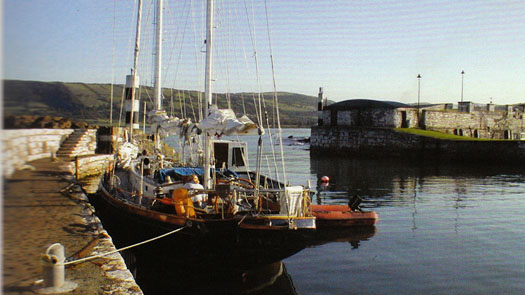
You wouldn't think you could get into a place as small as this, but research is everything....Xanadu in the tiny harbour of Carnlough on the Antrim coast. Photo: Geraldine Hennigan
But without the income of a skippered-charter operation, maintaining a steel ketch of this size and age was becoming impossible. In order not to be impossibly heavy, steel yachts have to be built with only 6mm plate, which is fine for strength but leaves nothing extra to allow for the local corrosion which is almost inevitable and difficult to detect when complex accommodation is fitted into hulls sprayed internally with insulation. Thus even with high level maintenance, it is reasonable to expect that a steel yacht will last only about fifty years without major work being undertaken.
With Xanadu, it was the more visible bits of the ship – the cockpit coamings and cabin sides, for instance, the places in the spray areas - which were most prone to rust. But there were also enough questionable spots, albeit minor, on the hull itself, hidden away by bulkheads, internal furniture and fittings and so forth, which were a cause for real concern. For as long as he could, Norman replaced or repaired the corroding areas, but it was a growing challenge – the ship seemed to be in rapid decline.
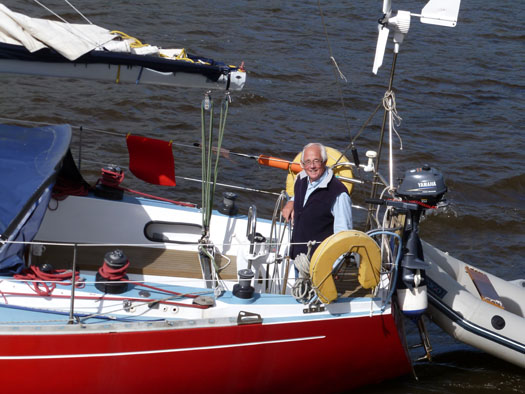
The surveying and research for the ICC Directions continued with boats loaned by members – Norman at work in Lough Foyle in 2013 aboard the 35ft Witchcraft provided by Ed Wheeler of Strangford Lough. Photo:W M Nixon
Xanadu was taken temporarily out of commission, but the ICC's research duties continued with boats loaned by members on all coasts of Ireland. Yet every time Norman and Geraldine returned from this absorbing work, they had to face again the problems with their own boat. It was decision time. They had to put Xanadu up for sale, ideally to someone who had the resources to refurbish a still eminently saveable classic. Or else they'd have to watch her rust away before their very eyes.
But the economic recession was in full swing. And selling a boat from remote Oldcourt Boatyard in far West Cork was a very different proposition from frequent showing to the boat-keen crowds who mill about places like Annapolis. The months passed, the years passed, there was interest, but there was nothing which converted into anything realistic. They made the decision that Xanadu was not going to make the 50 years which is the normal life-span of a fully-maintained steel yacht. Instead, she would end her days at the age of 32 while there was still a bit of dignity to it.
It's making the decision which is the really painful part. Once it's made, you're absorbed by the challenges faced in stripping a complex 48ft structure down to a shell, and selling the bits and pieces for sometimes surprisingly good prices, while keeping some special parts for possible incorporation in a new boat.

The last days of Xanadu. Seen here in June 2014, she'll be completely gone within a fortnight from today. Photo: W M Nixon
But as of this weekend, Xanadu is a bare shell, though still at home in the easygoing world of a friendly local boatyard. However, within a fortnight, this empty shell will be moved to the very different world of a scrapyard, and the final coup de grace will be delivered in a matter of hours.
In our modern world, in which such harsh events are kept hidden by professionals from sensitive eyes, we now and again need to reflect on the final reality. But despite Xanadu's fate, there are still many people who continue to preserve old boats for whatever reasons, and by very different means. So we'll round out this piece with the two very different stories of two historic boats which had very special links with Dun Laoghaire and Dublin Bay.
Espanola has sailed through this blog before. A 47ft cutter designed and built by Sam Bond at Birkenhead on the Mersey in 1902, she was originally called Irene VII, but in 1912 she was bought by Herbert Wright of the Royal Irish YC on Dublin Bay who'd been a founder owner in the Dublin Bay 21 class the year Irene was built. He actually cruised his DB 21 Estelle, which must have been an austere business, but certainly Irene seemed luxurious by comparison. And when the King of Spain visited the RIYC clubhouse during a formal visit to Ireland in 1912, as Irene on her moorings was the nearest boat to the clubhouse of any comfortable size, he was taken aboard her to see an Irish yacht, as he was himself a keen sailing man. Almost immediately, Herbert Wright - a fast-thinking stockbroker - re-named his new boat Espanola, and she has been Espanola ever since.
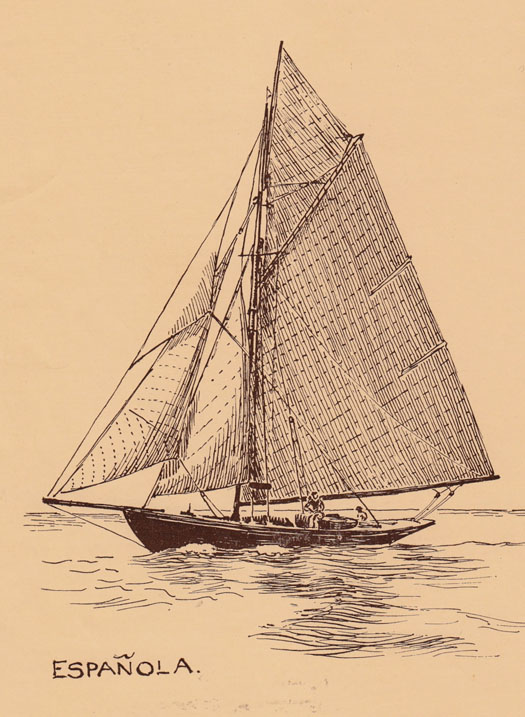
Espanola as she was in 1929. (from a drawing by Billy McBride)
In Herbert Wright's ownership, she made some notable cruises, indeed he was so highly regarded in the Irish cruising community that when the Irish Cruising Club was formed with a cruise-in-company of just five yachts to Glengarriff in 1929, Espanola was one of them, and she came back to Dun Laoghaire as the new ICC Commodore's yacht. It was a role she continued to fill for a dozen years, so it would be quite something of she was still around for the ICC's Centenary in 2029.
Since leaving Ireland in the 1940s, she has had a varied life, but for many years now, she has been owned by Martin Birch, a lecturer at Lancaster University. This means his home port is Preston on the Lancashire coast with, its huge tides and shallow channels. Espanola is very deep draft, so if you set out to choose an unsuitable home port for her, Preston would come well up the list, except that the folk in Preston Marina have adopted her as their sort of pet classic yacht, so Martin has had every assistance possible to keep his big boat in pristine condition.
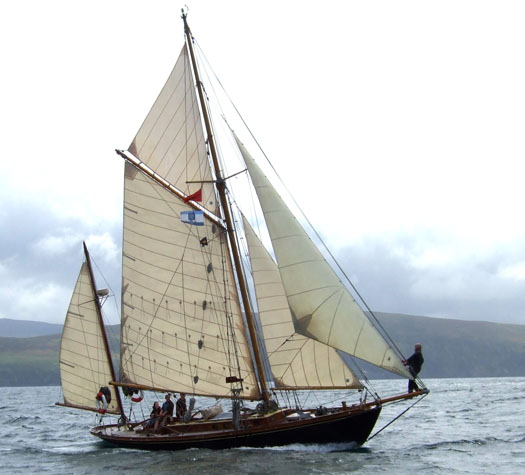
Espanola as she is rigged today, with a more manageable gaff ketch configuration.

Espanola is currently afloat under these high quality covers in Preston in Lancashire. Photo: Martin Birch
That said, when planks needed replaced she had to be taken to the Menai Straits and one of the boatyards there which are carving out a formidable reputation for quality work on classic and traditional craft. Getting Espanola to the Straits was no bother, as Martin has made some fine cruises with her, notably to the Outer Hebrides. So Espanola is in good shape for a boat of her age.
But after 25 years of total dedication in looking after this big vessel in challenging circumstances, Martin has decided it's time for a change, and Espanola is for sale. However, for someone looking for a flawless classic yacht pedigree, while her hull is totally authentic, Espanola's rig has now been changed from a big gaff cutter to an easily handled ketch, though still gaff rigged, while her accommodation has been made much more comfortable and roomy by the addition of an elegant full-length coachroof.
So today's Espanola is not totally as she was in 1902, but her full history has been traced by Martin Birch, and he has written a privately-published book about it which very effectively reveals why this is an important boat, though a challenge for any owner. However, if you're interested I'll put you in touch with him, but this isn't one for the faint-hearted.
But then, keeping any classic or historic vessel in seagoing shape is never something for the faint-hearted, so we'll conclude with a totally different approach to the methods adopted in the case of Xanadu and Espanola. It must be nearly ten years now since the six surviving Alfred Mylne-designed Dublin Bay 24s were spirited away to Brittany for a planned complete re-furbishment and their intended re-emergence as classic playthings for the mega-rich at a new resort centre to be built in the south of France.
The re-born class was to be known as the Royal Alfred 38s, as 24ft is only their waterline length, and people go by LOA these days. As to the Royal Alfred, it supposedly sounds more posh than Dublin Bay, and it was at a committee meeting of the Royal Alfred Yacht Club in Dublin in 1934 that Gordon Campbell, the second Lord Glenavy and owner of the Dublin Bay 21 Garavogue, first outlined the concept – and a very advanced concept it was too – for a larger more modern Bermudan-rigged one design for racing in Dublin Bay, and capable of some modest cruising.
By 1938, Dublin Bay Sailing Club took over the project, and a design was commissioned from Alfred Mylne in Glasgow. But though building work started in Scotland in 1939, World War II delayed everything, and the class didn't have their first race at Dun Laoghaire until 1947. They were an immediate success - they filled Gordon Campbell's brief to perfection, and for more than five decades they'd great racing in Dublin Bay, they also logged some truly remarkable cruises, and for good measure they did the business racing offshore, with one of them the overall winner of the RORC Irish Sea Race in 1963.
But the setup in Dun Laoghaire does not favour the continued existence of a class of 38ft classic wooden yachts, so the DB 24s had definitely run out of steam when they were swept up by the Royal Alfred 38 consortium. Then the recession arrived, and all sorts of rumours circulated about the boats being held as security against debts, of them being piled away any old how in a warehouse near Benodet in Brittany, and of lots of other things, none of them good news.
That is, until somewhere over a month ago, when I heard from an acquaintance with a Classic in the Balearics that he'd heard a rumour a restored Dublin Bay 24 had been seen sailing in the inner reaches of the Bay of Biscay, and seemed to be very much at home there. This I thought rather good news, as it seems to me to be a much more appropriate setting for these very special boats than the French Rivera with its harsh sun, where the classic yachts are so large that the Dublin Bay 24s, or whatever they were to be called, would be virtually invisible.

The new Dublin Bay 24 Periwinkle sailing off La Turballe, August 2014
For once, it's good news, albeit with a slightly sad tinge. The slightly sad note is that the Dublin Bay 24 Periwinkle, which never left her birthplace in Scotland and was only united permanently with her sisters when they were all shipped to Brittany several years ago, is now absolutely no more. Well, her tiller still exists and is in use, but whether that's the original tiller from 1948 is another matter. And her lead ballast keel still exists. But the rest of Perwinkle is totally gone, burnt to ashes. Yet Periwinkle still sails, and is looking very well indeed.......
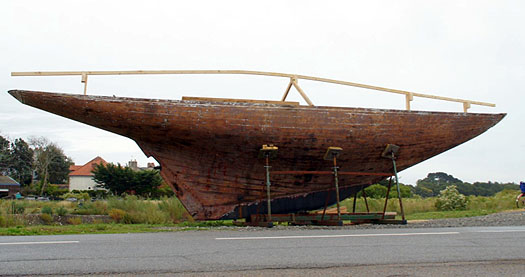
Last glimpse of the 1948 Periwinkle, September 2012
It's quite some story. In 2012, the original Perwinkle was bought by the Francois Vivier organization in France, which specializes in classic boat-building to the highest professional standards, and also creating designs – some of them distinctly quirky, and some which can be built by amateurs. The ideals behind it all have taken off in such a big way in France and abroad that there's an almost religious fervor to some of Vivier's adherents, and the story of Periwinkle will in no way diminish this.
For they took the original Periwinkle, and with a team of qualified shipwrights and trainees, they meticulously took her apart bit by bit in order to see how she had been built, and to give them the information to build an exact replica, albeit in different wood technologies such as the use of laminated frames.
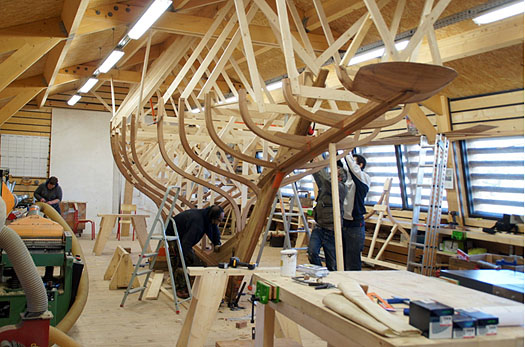
Perwinkle built anew – the laminated frames go into place
Looked at a certain way, it's all a bit morbid – we're in the surgeon's dissecting theatre here. And no, I don't know if they had an audience, but it's for sure they would have had no troubling assembling one. Then, with all the information to hand, and with every last little dismantled bit and piece for further confirmation, Francois Vivier drew out new plans for the re-construction. Periwinkle re-born took to the water in August this year, and she looks only gorgeous.
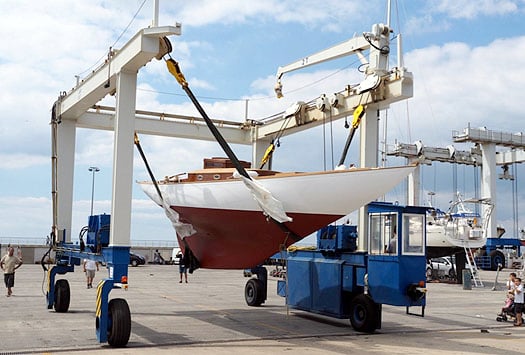
The new Periwinkle on her launching day – she'll be known as a Dublin Bay 24

With her teak decks looking immaculate, the new Perwinkle goes afloat for the first time.
You'll be glad to hear she's known as a Dublin Bay 24. And such is Francois Vivier's following, I wouldn't be at all surprised to hear of a new class in the making on France's Biscay coast. For with Gordon Campbell's vision, the further experienced input of the committees of both the Royal Alfred Yacht Club and Dublin Bay Sailing Club, and Alfred Mylne's genius, they got one marvellous yacht.
So there it is. The three choices with an important but ageing classic yacht. Euthanasia. Or the continued dogged preservation against all the odds. Or a complete re-build. Not easy, any of them.

No, you're not seeing things, this is undoubtedly a very new Dublin Bay 24. But it would be impossible to quantify how much she cost, as the entire dismantling and building project has been part of a larger training progamme.
Who Runs Dublin Bay, The Capital's Waterborne Playground?
#dublinbay – Who runs Dubli Bay? Dublin is gradually getting to grips with the sea. Ireland's relentlessly growing and developing capital city is learning that interactive living with the sea and the city's River Liffey, for trade and recreation alike, should be a natural priority for a major coastal conurbation of this status and potential. Thus, formerly derelict industrial waterfront and dockland sites are being re-configured for recreational and hospitality use. And Dublin's ancient maritime communities are learning more of their maritime heritage, and how it can be better understood, both to make these areas more attractive to live in, and to attract visitors. W M Nixon highlights some recent events which show the way forward, but begins by wondering just who's in charge?
It's a good question. For starters, what is Dublin Bay? To keep things as simple as possible, let's agree that Dublin Bay is the area westward of a line between The Baily headland to the north and the Muglins to the south, enclosed then by a dogleg south of Dalkey Island across to the mainland's Sorrento Point at the lower end of Dalkey Sound.
As to how far westward you can reasonably include waterways in the navigable bay area, for simplicity we'll discount the two canals – the Royal and the Grand – radiating from the docks, except for their dockland basins. And as for the River Liffey itself, at high water it may be navigable as far as the weir at Islandbridge, but for most craft, height restriction means that you can go no further than the Matt Talbot Bridge, and even then you're relying on the opening of the Eastlink and Sam Beckett bridges.
So in all we're looking at an area about six nautical miles north to south at the most, and seven miles east to west. But as the east-west dimension is only three miles of open water at low tide, we're looking at a very busy little bit of sea, where multiple uses can often result in potentially conflicting interests trying to share space with each other, while demands on the relatively small sections of accessible waterfront can become acute.
Time was when there was a clear pecking order among the port and bay users, based on commercial demands and the social status of the different activities. Within Dublin port, the Port & Docks Board was effectively its own empire. It had to function effectively, wash its face in financial terms, and get on with the job - and that was it.
While some individual members of the Board may have been concerned with its public image, as perhaps were some of the employees, for the most part it was in the business of making money out of handling ships and their cargoes, and the bigger the better, and that was it – they definitely weren't into public entertainment or the accommodation of the needs of smaller craft. Thus in Dublin as at other ports throughout much of the world, small boat ventures and fishing in particular got little attention – fishing boats and their crews had to make do as best they could with often woefully inadequate facilities.
But as recreational boating developed, new factors came into play. Money talked, and it could be the case that the new breed of recreational sailors were themselves board members or senior professional employees of the Docks Board. And as the new asylum harbour at Dun Laoghaire had developed from 1817 onwards, recreational sailors had the social and economic clout to secure themselves key sites for their private club facilities at this attractive new location.
But that was then. Nowadays, the old system of each interest looking only to its own concerns, and everyone minding their own business if at all possible, just doesn't work any more. The city is bursting at the seams with a new vitality seeking fresh recreational expression, and access to Dublin's maritime heritage. Public and semi-state bodies such as Dublin Port are expected to be much more aware of their image, not only for the general good, but because it has been shown that people much prefer to be working for an organization which is well thought of in the larger community. This means that even the most commercially-minded members of the Port board accept that in the long run it makes economic sense to hold open days, Riverfests, "fun for all the family" happenings, and so forth.
But as this outgoing approach develops, somebody has to be running the show. So who's in charge of the greater bay area? At national governmental level, at the very least the requirements of the Marine Section of the Department of Agriculture and whatever are relevant. So are those of the Departments of Transport, Tourism, and the Environment.
Then there's Local Government. The north side of the bay comes under the Independent Republic of Fingal, which also touches the western navigation limits of the Liffey, as Fingal somehow incorporates the Phoenix Park. Then Dublin City takes over in the inner bay, but South Dublin may think it has some sort of say-so on the innermost bits of the Liffey to the southwest. Southeast of Dublin port, and you're very quickly on the Golden Road to Samarkand, in other words you're into Dun Laoghaire-Rathdown.
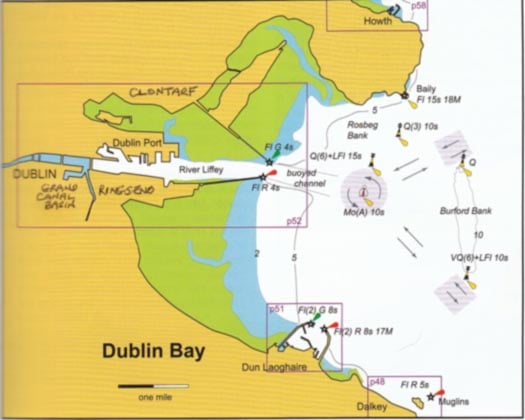
A busy little bit of water. Everyone wants a piece of the action on Dublin Bay. Plan courtesy Irish Cruising Club
You'd think that's all enough to be going along with, but bear with me. As far as administration of the built waterfront environment administration is concerned, we're only starting. King of the scene has to be Dublin Port, which really is the big beast in the administration arena. But snapping around its heels on both sides of the Liffey is Waterways Ireland, which has its canals north and south of the River. While WI may have allowed a reduction of the Spencer Dock going into the Royal Canal, across the river the sea-lock-accessed Grand Canal Basin on the south side has the potential to be the jewel in the Waterways Ireland crown, as it has a location to die for and the kind of industries which local authorities dream of – if California has its Silicon Valley, Grand Canal basin is Dublin's Silicon Harbour.
Despite the all-Ireland spread of its remit, Waterways Ireland is a smaller creature than Dublin Port, but you get an increasing sense of boundaries being claimed and defined as this once forgotten area of Dublin docklands comes rapidly alive. And of course another player in our list of statutory authorities which are very interested in the administration of the Dublin Bay area is the Docklands Development Authority, or whatever it's called now in the hope that we'll forget the debacle over the Irish Glass Bottle site.
So our chums in NAMA also have a decision-making role. And then, back in the water, the fact that the Liffey is a living river means that Inland Fisheries is another body than can be rightfully involved, as can organisations concerned with the well-being of those two important tributary rivers, the Dodder to the south and the Tolka to the north.
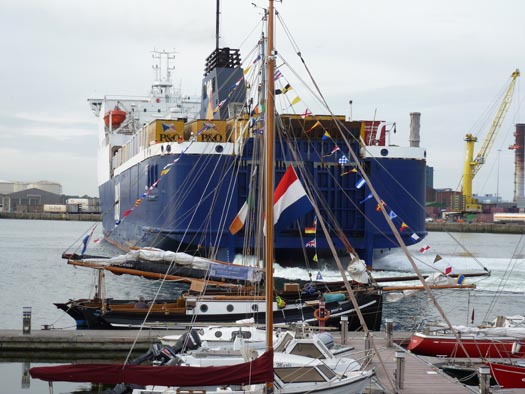
Sometimes it can seem too crowded for comfort. Ships and smaller craft share a narrow bit of water at Poolbeg. Photo: W M Nixon
All this complexity of administration in the Dublin Bay waterfront may seem convoluted enough already, but we haven't even got to Dun Laoghaire yet. There, the local council have put up the gross new library building as though to offend the other buildings on the established waterfront just as much as possible, while the Harbour Company is actively seeking ways of increasing its income – largely through accommodating cruise liners – as Dublin Port has been hoovering up the cross-channel car, passenger and ro-ro traffic through economies of scale.
Doubtless there are other statutory bodies which may be able to declare a legitimate interest in the running of Dublin Bay, but that's enough for now, so let's look instead at the consumer organisations. At a rough count, I can come up with twelve yacht, boat and sailing clubs, eight of which have premises. There are also at least six coastal rowing clubs, and five sea angling clubs. And there are several national boating bodies, all of which inevitably see a numbers concentration of their membership in the Dublin area, even if they conscientiously ensure that their administration reflects their nationwide nature.
If we really wanted to spread the net, we could come up with significant organization numbers for kite-surfers, windsurfers, canoeists and kayaks too. Plus there are two excellent links golf courses with their clubhouses right in the bay, on Bull Island. And finally, let's not forget Dublin Bay's own very special landmarks, the unused Smokestacks of Poolbeg. Boat users definitely want to keep them – at the very least, they tell us where we are. So we now have the ESB – or is it Electric Ireland these days? – central to a decision which is of great interest to Dublin Bay users.
By all means, let us know at Afloat.ie if you think there's a real need for some overall authority for the bay which can maintain the balance between sea and land, and between work, trade and recreation. It might seem like a good idea. But do we really need yet another level of bureaucracy? Yet another group of Jacks-in-Office who may even have staff with peaked caps and regulatory authorities which enable them to interfere with our natural freedoms?
It's a moot point, but I'll conclude with some experiences of how Dublin Bay is coming along as a genuine amenity for all, and look at some areas of developing interest. Of course, not everything in the garden is lovely. A public event which may have been a good idea on its first staging can become a bit jaded in its second year round, and this seemed to be the case with Dublin Port's Liffey Riverfest.
Last year, it had the attraction of novelty, and it included some Tall Ships, and also the major visit of the Old Gaffers Association international fleet in their Golden Jubilee Year. There was a busy shoreside carnival and many waterborne events including the Ballet of the Tugs and a race series for the historic Howth Seventeens. The restaurant Ship, the MV Cill Airne, provided an excellent administrative and hospitality centre, while downriver Poolbeg Yacht Boat Club's marina provided a very effective main base. It was all great fun.

The "Restaurant Boat" MV Cill Airne has proven very popular with visiting sailors in Dublin Port, but they'd like it even more if they could berth right at the ship. Photo: W M Nixon
So this year they extended the Riverfest to maybe five days in all, and for many who had been there in 2013, it seemed a bit jaded. They'd stepped up the shoreside entertainments, and noisy "fun for all the family" meant less fun for those afloat. The Howth 17s had dutifully turned up to put on a demonstration race or two, but this time round it seemed to be seen as no more than handy background moving maritime wallpaper. And as for the waterborne Ballet of the Tugs (now a daily occurrence throughout the Riverfest), those of our crew who had been there in 2013 said it wasn't nearly as good as last year, but one who hadn't been there in 2013 couldn't believe this - he thought it was absolutely marvelous seeing it for the first time.
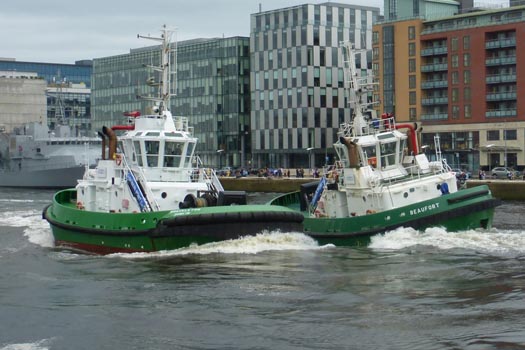
The Waterborne Ballet of the Dublin tugs Shackleton and Beaufort impresses those who haven't seen it before, but old Riverfest hands are always looking for something new. Photo: W M Nixon
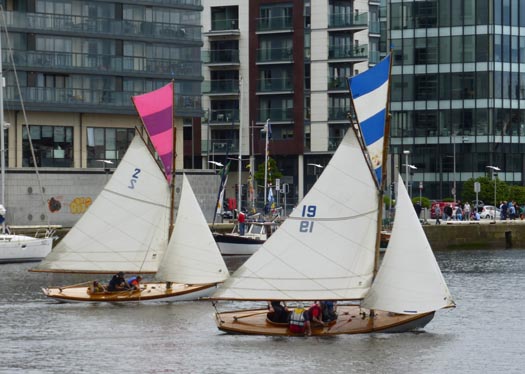
The Howth Seventeens do their duty with racing in the Liffey in the Riverfest, but for a fickle crowd on the quays always seeking fresh entertainment, the classic old boats are really just a form of moving wallpaper. Photo: W M Nixon
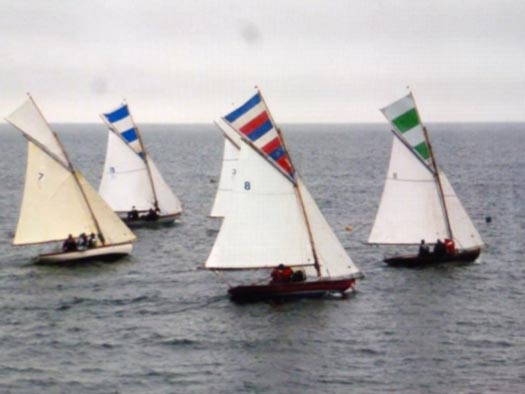
The Seventeens doing what they do best – getting in a bit of real racing. This is the leading group headed for the Clontarf At Home in July, and then on to Ringsend for Echo's Centenary Party at her birthplace. Although Echo (number 8) was the birthday girl, Deilginis (No 11) won the race to Clontarf.
Nevertheless, the old Howth Seventeens had done their duty by the Riverfest at the beginning of June knowing that later in the season, they'd have a weekend completely tailored to their own needs. The Lynch family's Howth Seventeen Echo was built in Ringsend in 1914, the only boat of the class to be built in that ancient maritime community of boatbuilders and sailmakers. So in July the class had their traditional race round the Baily to the Clontarf Yacht Boat Club At Home - an event which is totally tide dependent – then as the tide started to recede, the Seventeens got themselves round to hospitable Poolbeg.
There they were given a snug berth within the marina (most welcome as a giant cruise liner came up the river), then after a Centenary Party in PY & BC which is as near as boats can now get to Echo's birthplace in Ringsend, the party went up the quays to the Cill Airne for a dinner hosted by the Lynches, then after over-nighting at Poolbeg, on the Sunday they sailed home – mostly crewed by families – with a fair wind for Howth to round out a perfect couple of days.

The Howth Seventeens were very glad they'd been put in an inside berth at Poolbeg Marina in July after coming round from Clontarf, as the 113,000 ton cruise liner Ruby Princess was next up the river. Photo: Cillian Macken
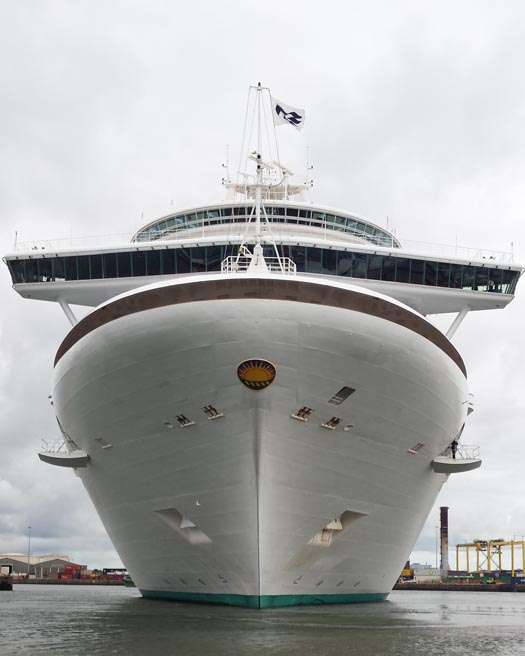
The Ruby Princess goes astern into her berth in Alexandra Basin with her bow only yards from boats in Poolbeg Marina. Photo: Cillian Macken
In other words, it was exactly the kind of weekend that most classic local one designs will enjoy hugely, but as entertainment for non-participants and spectators, it wouldn't have registered at all. This is the quandary which harbour authorities have to cope with in trying to give themselves a human face. You're either into boats and other waterborne vehicles, in which case almost anything to do with them is wonderfully entertaining. Or else you're not, in which case total incomprehension, and the ready seeking of almost any other kind of entertainment – and the noisier the better - is almost inevitable when you try to get general public interest and involvement.
Obviously the visit of a significant Tall Ships fleet is something whereby a port authority can combine both genuine maritime interest and public entertainment, but securing one is a major challenge. However, in Dublin port the new user-friendly attitudes have seen the extension of the pontoon beside the Point Depot just above the Eastlink Bridge, and while the rally of the Cruising Association of Ireland was a matter of the crews of around forty boats getting together and enjoying themselves rather than some high profile public entertainment happening, it certainly provided a useful insight into what boat visitors expect in a port.
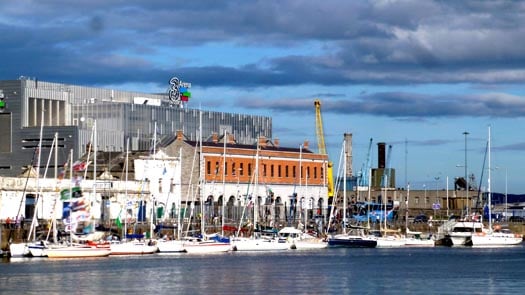
The Cruising Association of Ireland fleet was a fine sight at the new pontoon.......Photo: W M Nixon
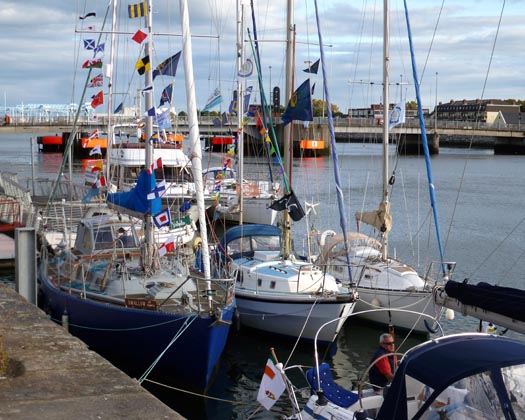
....but because of the need to keep the fairway through the Eastlink Bridge clear, they could only raft three deep. The blue boat in the foreground is Wally McGuirk's own-built 40ft steel Swallow, the last design by O'Brien Kennedy. Photo: W M Nixon
So I might as well start with the bad news. A forthright opinion came from the most experienced cruising man present. In a notably experienced group which included Wally McGuirk's very special own-built steel 40-footer, Swallow, the last boat to be designed by O'Brien Kennedy, being the most experienced is quite something. But whatever it means, it doesn't necessarily include diplomacy. When I asked this most experienced of all the cruising folk present what he thought of the new pontoons, he briskly replied: "They've put them in a stupid place. They should be up beside the Cill Airne, which is where everyone wants to be, and not down here beside the Eastlink Bridge with the likelihood of noisy crowds coming out of the Point Depot at a late hour, and the traffic on the bridge, which also means that we can only raft three deep in order to keep the channel under the bridge clear".
In fact, the CAI's end-of-season rally had a problem of success. Forty boats turned up to provide an impressive fleet but the most they could have at the pontoon, even with rafting, was thirty, so ten had to return through the bridge to Poolbeg where they'd been hospitably received the night before.
Once again, choosing the Cill Airne as the venue for the night's entertainment and meal proved a success, so ideally what's needed is berthing pontoons surrounding the ship herself. It would be mighty convenient, and also solve the inevitable security problems inherent in berthing in a city. But quite what shore-based hospitality establishments in the area would make of a ship in the river receiving such preferential treatment in the guiding of everyone's potential customers is another matter.

While the sea lock into the Grand Canal Basinon the south side of the Liffey went unoccupied the CAI fleet milled about to find berths on the North Quays. Photo: W M Nixon
However, across the river through a sea lock into the Grand Canal Basin, and you're into a snug and secure place that is surely a popular cruising destination that's just waiting to happen. Admittedly in Ireland people seem to have an aversion against having to transit a lock to enter port, but as they'll already have had to come through the Eastlink, having the lock ready can be part of the package. Within, you're totally secure, safe from big ships in the river and within easy reach of many facilities, including even the Daniel Liebeskind-designed Grand Canal Theatre.
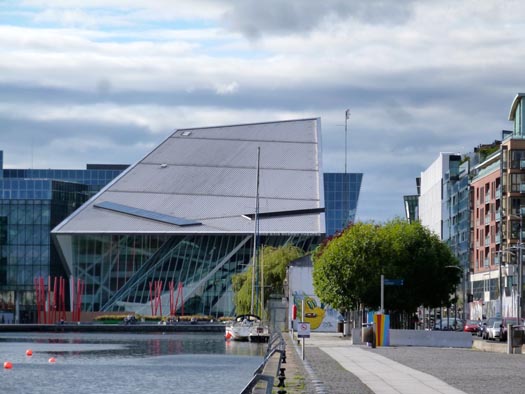
The total shelter of the Grand Canal Basin beside the Liebeskind-designed theatre. Photo: W M Nixon
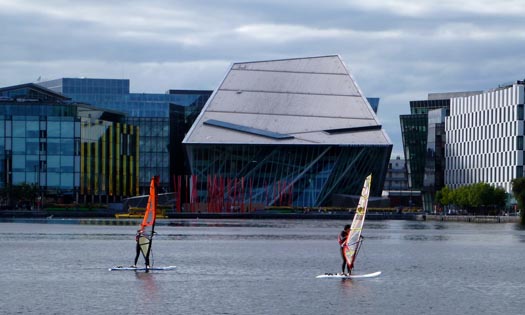
Even with other users such as trainee windsurfers and the Viking Splash ambhibian using the rad Canal Basin, there is still plenty of room for visitors. Photo: W M Nixon
Now that it has been sold to people of taste and discrimination, presumably we can hope that its clumsy current name of the Bord Gais Energy Theatre can be changed pronto. Admittedly there used to be a beloved little venue in Dun Laoghaire in the 1950s and '60s which was the Gas Company Theatre, and many a sailing person enjoyed an entertaining night of drama there. But times have moved on, and even public utilities have to be given more interesting and original names. Certainly when you have a situation where people unfamiliar with the First Official Language think that Ireland's newest and most glamorous place is known as the Bored Gosh! Energy Theatre, then something drastic yet creative has to be done.
Being in and around the Grand Canal Basin – which dates back to 1796 – really does give a sense of the past, even if many of the buildings are very new. But just across the River Dodder is Ringsend, and that is a place which is re-discovering its history as one of Ireland's most interesting maritime communities.
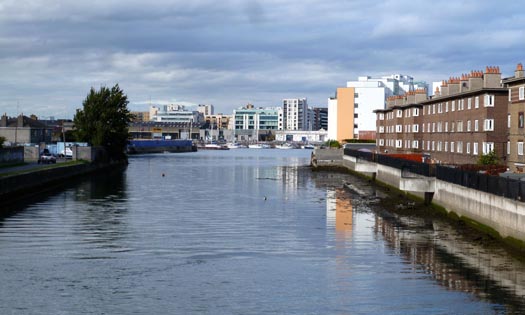
The view northward down the River Dodder from Ringsend Bridge towards the Point Depot on the other side of the Liffey. The entire riverbank on the right used to be a mix of boatyards and other marine businesses, but all that was swept away when the Thorncastle Street Dublin Corporation flats were built in 1954. Photo: W M Nixon
A packed house in Poolbeg Y & BC on Thursday night heard Cormac Lowth talk on the distinctive Ringsend sailing trawlers, and how they traced their development directly back to the arrival of Brixham trawlers from Devon, which were able to begin fishing the Irish Sea in 1818 a couple of years after the end of the Napoleonic Wars.
Brixham was a hive of fishing development and expansion at the time, and their fleets ranged the seas between Dublin Bay to the northwest and Ramsgate in Kent to the east. They originally were enticed to the facilities at the little Pigeon House harbour down along the South Wall, but soon crews were settling, such that nowadays in Ringsend there are still several prominent surnames which can be traced directly back to Devon.
With the Irish community established, there was much intermarriage, and the locals soon acquired the imported skills. Ringsend in those days was almost an island, and with its characterful fishing community, it attracted artists such as Matthew Kendrick and Alexander Wiliams, both of whom lived in Thorncastle Street, the main thoroughfare where the houses backed onto the River Dodder, along whose banks marine industries prospered.
Ship-building flourished, and one of the most talented families in this craft was the Murphy clan, who built on the banks of the Dodder (and then themselves fished) one of the mightiest cutters of them all, the 70ft St Patrick. But the demands of sailing such a boat with the standard crew of just three men and a boy were such that subsequent boats of both Brixham and Ringsend were ketch-rigged, and it's the ketch-rigged 70-footers such as Provident which we know as the classic Brixham trawler today.
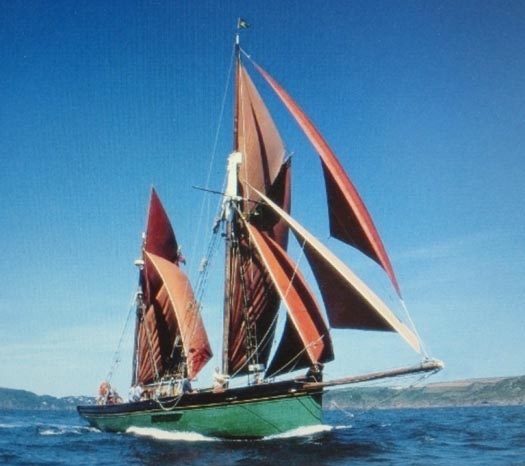
Provident, built in 1924, was one of the last and one of the best of the famous Brixham sailing trawlers.
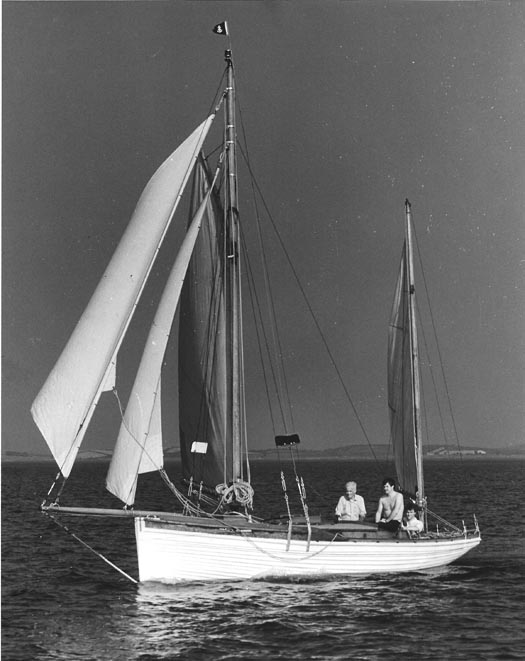
The 28ft Dolphin, built in 1924 in Ringsend, was a final acknowledgement of the hundred year old link to Brixham. She is seen here on Strangford Lough in the 1960s in Davy Steadman's ownership. Photo: Ann Clementston
Provident was built in Devon in 1924, by which time steam was already displacing sail as the preferred power system for trawlers. The effects of World War I from 1914-18 and the War of Independence in 1921 had further reduced the already much-weakened direct links between Brixham and Ringsend, but in 1924 the young designer-boatbuilder John B Kearney built Dolphin, a 28ft clinker-built gaff ketch, in Ringsend. Her design was a final salute to the Brixham connection, for in shape she was completely different from all Kearney's other yacht designs.
Dolphin has sailed through these columns before, but she deserves to be remembered again. And Cormac Lowth's wonderful lecture – it was utterly brilliant - brought the thought of her back to mind, for she's still around. So if anyone wants to make a small fortune, they first should first make a very large, indeed an enormous fortune, and then undertake the challenge of restoring Dolphin. She lies in a very sorry but still just about restorable state in a boatyard on Cork Harbour. Put her right with your large fortune, and you can be reasonably sure of having a small fortune at the end of it, but thre'll be a job which was well worth doing properly completed.

A very sad sight – Dolphin as she was in July 2014, at a boatyard on the shores of Cork Harbour. Photo: W M Nixon
Boating Visitors To Ireland's South Coast Get Mixed Welcome Messages
#marinetourism – Ireland's south coast provides an almost infinite variety of harbours, natural havens, and extensive areas of interesting sailing water. These cater for boat enthusiasts of all kinds, with craft of every type. So how does the welcome for visitors shape up? W M Nixon contrasts the different hospitality styles of four attractive ports.
The word on the grapevine that the Ballydehob Old Boat festival had taken place arrived with an intriguing photo from Anthony O'Leary. It had been noted in the interview with him immediately after he had led the team in Ireland's Commodore Cup Victory, that while he was trying to unwind for a while, it's not really in the O'Leary makeup to relax, and soon his mind was busy with new ideas of nautical interest.
Nevertheless he was cruising gently in early August down towards West Cork in the family's handsome big Nelson powercruiser Irish Mist, a fast and able vessel which his father Archie and mates like Mick Ahern once took right round Ireland in a settled springtime spell of weather, just to be in Dublin to watch Cork Con play rugby in some major championship at Lansdowne Road.
As it turned out, this year Irish Mist was getting down west ultimately to be in Baltimore for the 1720 Nationals in late August, which O'Leary duly won. But from time to time, he flashed back some photos of interesting boats met along the way, and one which really rang the bell was a little Ette Class clinker-built gunter-rigged sloop sailing in Castlehaven.
The Ette class originated way way back, when two keen dinghy cruising types sailed their little dinghy into Castlehaven, and the Castletownshend locals in the South Cork Sailing Club were so taken by the boat that they commissioned the waterfront boatbuilders, the O'Mahony brothers, to build some sister ships as the basis of a class.
All the new boats' names ended in "ette". And the class survived for many years, though at times the Ettes were hanging on by a thread. But recently it has had a fresh lease of life with new examples of what is now a classic dinghy being built by Lui Ferreira of Ballydehob, who last came through this parish when, in 2012, he put the first teak deck on a vintage Howth 17, the syndicate-owned Deilginis.
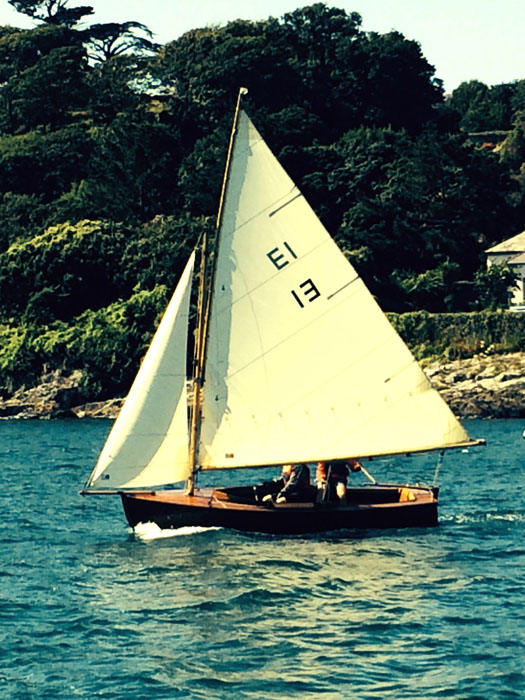
Perfection of summer – an Ette class in her home waters of Castlehaven. Photo: Anthony O'Leary
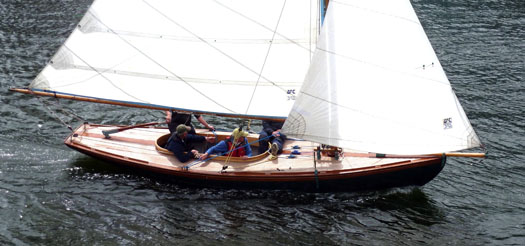 Rui Ferreira, builder in Ballydehob of the Ette Class, also put this teak deck on the 107-year-old Howth 17 Deilginis in 2012. Photo: W M Nixon
Rui Ferreira, builder in Ballydehob of the Ette Class, also put this teak deck on the 107-year-old Howth 17 Deilginis in 2012. Photo: W M Nixon
A Howth 17 looks well no matter how you photo her. But an Ette is a quirky little thing which can sometimes look odd from the wrong angle. Yet in a flash of inspiration, the Captain of the Commodore's Cup team took up his iPhone as an Ette came bustling down Castlehaven on fine sunny morning, and we got what I reckon to be one of the best photos of an Ette under way ever obtained – plus it gets the very essence of summer in Castlehaven.
The next O'Leary snap some days later was just briefly titled: "The Ballydehob Old Boat Festival, Irish Mist in archway second left". What was going on here? We'd heard vague stories about a very relaxed assembling of boat at high water at the drying quay at Ballydehob, but the O'Leary photo hinted at serious numbers and a high level of organization.

The teaser photo – first intimations of this year's Ballydehob Gathering of the Boats, with the O'Leary family's motor-cruiser Irish Mist (framed in the second arch from left) joining an eclectic group of 74 boats for a couple of hours at top of the tide. Photo; Anthony O'Leary
 This is most people's image of Ballydehob, crowded and very rural, with Mount Gabriel beyond. Only the more observant will notice the tidal river in the foreground. Photo: W M Nixon
This is most people's image of Ballydehob, crowded and very rural, with Mount Gabriel beyond. Only the more observant will notice the tidal river in the foreground. Photo: W M Nixon
To begin with, most casual visitors would scarcely think of Ballydehob as a seaport at all. Rather, it's the very essence of rural West Cork, a crowded little village where "laid-back" is the default mode, and it has been so for some time. It reached something of an apotheosis when Annie Barry (she's one of the Fergusons of Gubbeen Cheese) was running her wonderful Annie's restaurant on one side of the winding main street, and the Levis sisters Julia and Nell, feisty little ladies of mature years, were running Levis's pub across the way.
Julia and Nan were splendid folk of considerable standing, and it's said the pair of them were once squired to the West Cork Hunt Ball in Skibbereen by Jeremy Irons of Kilcoe Castle a few miles along the coast. As for the setup in Ballydehob, space was so limited in the restaurant that, having checked out your booking, you simply took up station in leisurely style across the street in the pub with Annie's menus and an aperitif or two, then Annie would come across the road and discuss your order, and a delightful evening would continue late into the night.
Alas, for some year now Annie's has been closed, though everyone lives in hope of somebody re-opening it. And in the pub, the old ladies have passed on. But now it's run by a great-nephew, and very successfully too. We got ourselves in there late on a velvet July evening this year to find the place was heaving with youth and beauty and high fashion in casual style - achingly trendy it has become.
It could have been a traditional local in any of the world's fashionable holiday areas except for one thing. A ball of fur, a terrier of some kind, emerged from among people's legs and barked its head off at me. I assumed it was because I carried a whiff of our own little Jack Russell. But the blushing girl owner told me with a big smile that her little dog must have thought I was a priest. Only along Ireland's south coast, near some former or still surviving Protestant enclave, would you have heard that particular excuse.
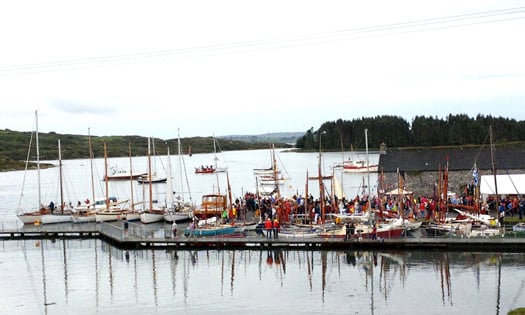 The old dock at Ballydehob is well able to receive a very varied fleet, seen here from the old railway viaduct Photo: Miriam Jones
The old dock at Ballydehob is well able to receive a very varied fleet, seen here from the old railway viaduct Photo: Miriam Jones
Just along the river from these scenes of hospitality and minor mayhem, immediately below the mighty railway viaduct which seems to be so disproportionate for the long-gone needs of the little West Cork Railway, there's Ballydehob Harbour. Time was when it was key to the place's economy, and it was in the late 1930s, only a year or so before World War II, that the Brooklands, the last surviving sail-only coasting schooner to deliver cargoes to West Cork, made her way up the winding estuary at the head of Roaringwater Bay (it's named for the Roaringwater River, much of the bay behind Carbery's Hundred Isles is well sheltered), to anchor just off the quay, as she was too deep to berth alongside.
The Brooklands was owned and skippered by Tom Creenan of Ballinacurra in the inner northeast reaches of Cork Harbour, but it was from Birkenhead or Goole on the Mersey that she'd bring her welcome cargoes of coal, a challenging passage at the best of times. At Ballydehob, while smaller cargo-carriers could get alongside the old quay, the Brooklands discharged her cargo into the multi-functional barge-type vessel known the Sandboat.
She was used by her owners, the Levis family, for just about everything, but primarily for going out among the islands towards high water, running up on a clean beach, then laboriously shovelling sand into the hold until the tide returned and the Sandboat could be floated off and piloted back to the quay where her eventually very useful cargo would be shovelled ashore to become builders' supplies.
The Sandboat was Queen of the Fleet at Ballydehob, and she played such a central role in the Levis family's life that Old Boat Festival organiser Cormac Levis's brother calls his pub in Ballydehob the Sandboat.
As for how Cormac himelf first got the notion for the Ballydehob Gathering of the Boats, he has been a tower of strength in the Traditional Boat movement, particularly in West Cork but also throughout Ireland, for many years. And with others following his example in restoring or even building new sailing lobster boats to traditional design, he suggested that getting together at Ballydehob during the little town's time-honoured summer festival around August 15th might hit the spot. And for the first one in 2004 –making this year's the tenth anniversary - they assembled nine boats, which was considered pretty good going.
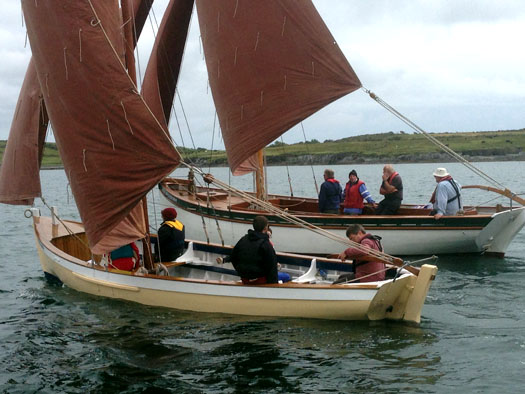
Close-up on Cormac Levis's lobster boat, which led the way for the first gathering of traditional craft at Ballydehob in 2004. Photo: Brian Marten
From it, they learnt that, for the future, while the aspiration would of course be for quiet and easy-going organization under a light hand, underneath it all there'd have to be efficiency, always with an eye on the clock. Although the tidal window is more than two hours for most boats, they've successfully accommodated modern yachts up to two metres draft without anyone being left behind stuck on the mud. But with limited manoeuvring space in both the harbour area and the channel, once the witching hour of high water is upon the fleet, it's time to start thinking about an orderly departure after two solid hours and more of good crack, mighty barbecues, and much interest in an examination of other people's traditional and classic boats.

Even among the sister-ships of the lobster fleet, many individual variants in hull lines and rig are apparent. Photo: Brian Marten

Just to add to the variety and colour, the Ilen Trust from Limerick brought their much-travelled Shannon Gandelows (right) to Ballydehob. Their stylish pennants are a legacy of heir successful visit to Venice at the end of April this year. Photo: Gary MacMahon
So the crucial thing is to select the ideal Saturday nearest to August 15th with a good big tide in mid-afternoon. As the Boat Gathering is such a force in its own right, they can range quite extensively on either side of August 15th, and to date the earliest has been August 8th, while the latest was August 21st.
This year's was Saturday August 9th, and while there may have been rain later in the day despite West Cork having much more sunshine in August than almost any other part of the country, no-body now remembers the rain as they recall the sheer fun and sense of community of what has been described by Tiernan Roe, another of the quality boat-builders of Ballydehob, as the "shortest bestest Boat Festival in the World".

Yet another creation of the active Ballydehob boat-building scene. This is an attractive little Cape Henry 21 cutter lunched in June by Tiernan Roe of Roe Boats. Photo: Tiernan Roe
For this year, it attracted 75 boats, though admittedly last year's record entry of 50 boats was greatly enhanced by this year's decision by the Drascome Lugger Association to combine Ballydehob in their 2014 cruise-in-company in West Cork, thereby adding 27 boats at a stroke.
But even with 27 boats of one class, the variety across the fleet as a whole was remarkable. So how do they assemble such a disparate fleet of boats with obviously highly-individual skippers, in such a quietly efficient way? For you'll never see or hear the Ballydehob Gathering of the Boats being publicly advertised all that much beforehand.
The method is perfectly simple. Everyone with an interest will know it is likely to be coming up on the agenda. So a month and more beforehand, Cormac will text them with the final date on a need-to-know basis. It works, and it sets the tone of quiet consideration for others and their boats in a very special festival in which some quiet sponsorship by CH Marine and West Cork-based German traditional boat fan Thomas Drewes sees that all participants get mementoes including cherished T-shirts (definitely not for general release), while barbecue facilities keep the good humour buzzing until everyone departs in style for their anchorage for the night, for although most boats hope to be berthed in Ballydehob on the big day more two hours hours before high water, once the ebb has started the channel has become much less forgiving about any pilotage errors.
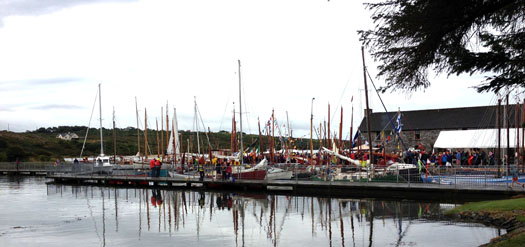
They're all here, as neatly berthed as you could please, but getting them away as the ebb starts requires good seamanship and boat-handling skills. Photo: Miriam Jones
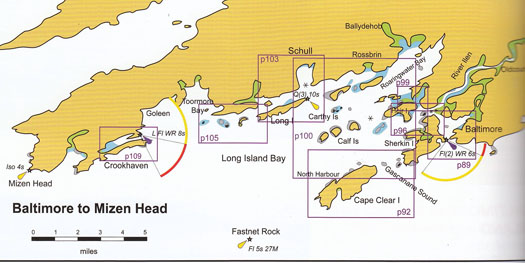
Ballydehob's central position in a hugely varied and welcoming crusing coast is emphasized by the number of other harbour chartlets indicated in this plan of the prime cruising area of West Cork. Plan Courtesy Irish Cruising Club
It's good to see a locally-focussed event like this now coming of age with a very healthy turnout. Eastward along the south coast, last weekend saw another event which will surely grow in stature and numbers, the second staging of Y2V Cruise-in-Company on the River Blackwater up the estuary from East Cork to West Waterford, as a flotilla of ten boats - eight GP14s, a Mermaid and a Feva – sailed up-river from Youghal to Villierstown.
It has been promoted by Youghal schoolboy GP 14 skipper Adrian Lee, and last year the inaugural tiny flotilla managed most of the sailable river by going to the bridge at Cappoquin before returning downriver to Villierstown. This year it achieved deserved support from the GP 14 class, with the furthest road-trailed from sea level being incoming Irish GP 14 Association President Stephen Boyle from Sutton DC, while the furthest-travelled in terms of elevation above sea level were the Blessington group, who came down from the Wicklow Hills with their Geeps and included Richard Street and kids (see again this blog on 26th July), and a brand new Duffin boat belonging to Simon Culley and Libby Tierney.
As for seniority, the classic of the class was a 60-year-old beautifully-restored Bell Woodworking GP 14 owned and skippered by 16-year-old Jack Nolan, another of that group of Youghal youngsters who are taking local dinghy sailing forward with gusto, while further variety was provided by Norman Lee of Greystones, his crew including the inevitable family pooches which are such a part of the GP 14 scene.
The sailing was mixed – as Norman said, in a river the wind will always be ahead some time, and though we think of the secret Blackwater Estuary as being fairly straight, in fact there are some quite significant curves. It took about four-and-a-half hours to sail up, and a brisker four hours to return on Sunday morning's ebb.
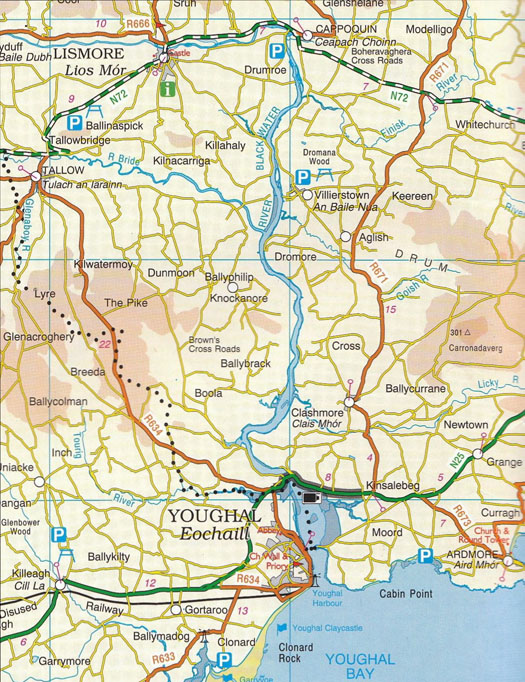
The secret waterway – the Blackwater Estuary from Youghal up to Cappoquin and almost to Lismore is one of Ireland's least-sailed rivers

Villierstown's new clubhouse, open only three weeks, was ready and willing to make welcome the crews who had sailed up from Youghal. Photo: Norman Lee

The new facility, Villierstown's "floating pier"
(right), was originally the in-harbour pontoon at Dungarvan SC. Photo: Norman Lee
At Villierstown, the new clubhouse of the Villierstown Boating & Activites Cub had been open only three short weeks, but they've made good use of a sports council grant, and it well fulfills a multi-purpose role, including providing the hospitality needed by sailing campers, with Paul Virtue and his wife Caroline organising a fine feast in the clubhouse on the Saturday night, and an enormous breakfast on Sunday to send them on their way downriver to round out an event which has future annual success written all over it.
One of the reasons it all went so well was that the slightly cogglesome little plastic floating jetty, along which the sailors of Villierstown used to access their small boats, has been replaced by a proper pontoon which the club acquired when Dungarvan SC eastward along the coast up-graded their in-harbour pontoon. In fact, Dungarvan support for the development of Blackwater sailing didn't stop there, as one of the fleet in the Y2V was a vintage Dungarvan-based Mermaid in which owner Eugene Burke has cruised the entire south coast between Ballycotton and Kilmore Quay.
The boat is Akita, Mermaid No. 85, and she has certainly been around, as she was built in the Barkyard in Skerries in 1953 by Joe and Matt Boylan. The Barkyard was originally the place where the Skerries-based coasting schooners and fishing boats had their sails preserved against rot by tanning with bark, but in the 1950s the now redundant premises were used to build some of the eventually enormous fleet of Skerries Mermaids through a boat-building class run by the colourful Jem Kearney.
The Fingal region around Skerries and Rush continues to be the great heartland of the Mermaids, with some very racy boats built in the old mill at Rogerstown recently, but despite the modern challenge, this year's Mermaid Week at Rush saw the champion emerge in the form of Jonathan O'Rourke of the National YC with his vintage boat, one of the few Mermaid sailors still in Dun Laoghaire.

The welcoming port. Despite its tidal limitations, Dungarvan lays on the welcome in a big way. This shows a visiting fleet at the original pontoon, which has now been moved to Villierstown. Photo Kevin Dwyer, courtesy Irish Cruising Club
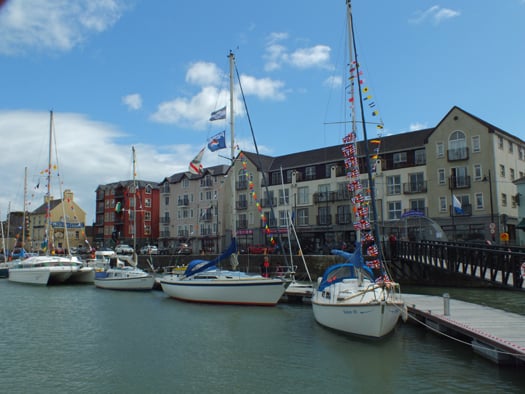
Dungarvan SC's new in-harbour pontoon has much improved the alongside berthing space, but unfortunately the local Council wouldn't permit dredging to improve access.......Photo: Donal Walsh

....and thus the reality for most boats in the Inner Harbour is a drying berth.......... Photo: W M Nixon
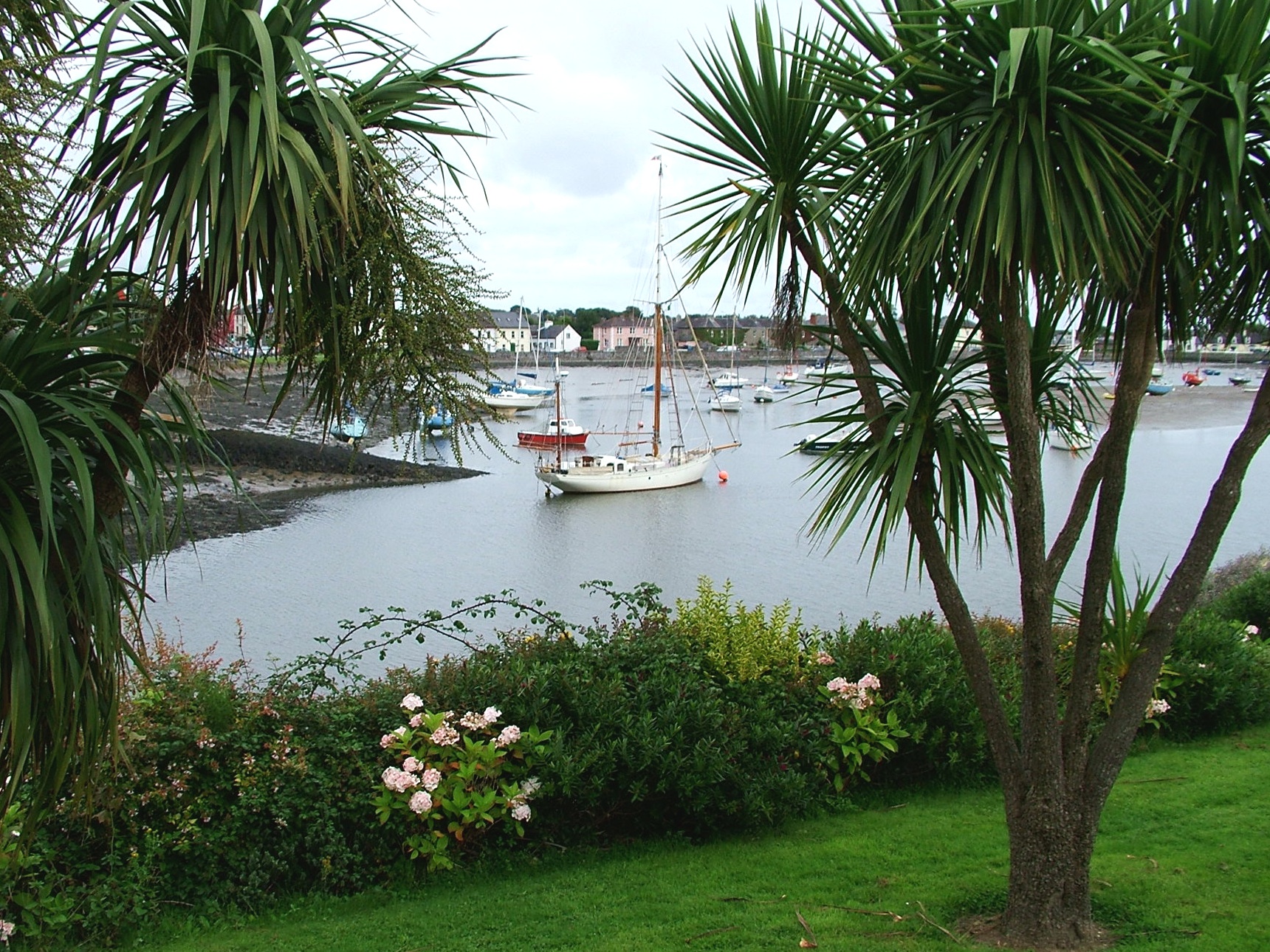
....but if you've access to local knowledge, there is a deep pool just below the bridge........Photo: Donal Walsh
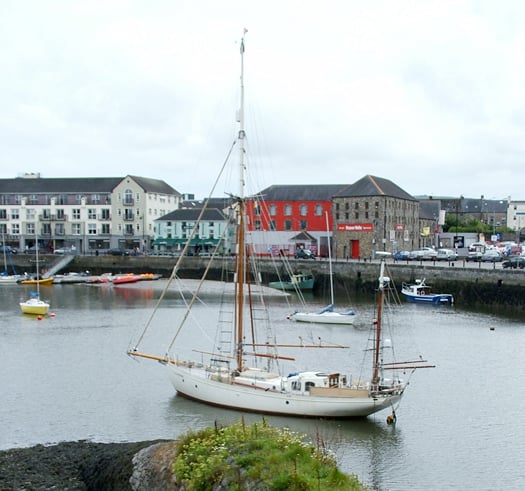
.....and here the Northwest Passage transiting 44ft steel gaff yawl Young Larry is visiting in comfort and style. Photo: Donal Walsh
Meanwhile in Dungarvan the club's hopes of doing a bit of dredging to improve access to their extended in-harbour pontoon was stymied when the council said they wouldn't permit any salt-contaminated sludge being brought up onto the quay. But despite its tidl limitations, it's a hugely hospitable place, and if you do take the ground at the pontoon, it's mostly soft and forgiving mud which enables you to sit in relative comfort. Certainly some very substantial cruising boat have overnighted here to enjoy the fine pubs both on the waterfront waterfront and in the town, while culinary standards are set by Paul Flynn's famous restaurant The Tannery just round the corner.
Nevertheless if you absolutely won't let your boat dry out, leading Dungarvan cruising man Donal Walsh (he has just returned from an epic round Ireland and Britain clockwise cruise with his Moody 31 Lady Kate) well knows the deep pool across the harbour close under the bridge, and he saw to it that his brother-in-law Andrew Wilkes and sister Maire Breathnaith found a secure berth there for their hefty 44ft steel-built gaff yawl Young Larry, a boat in which they transited the Northwest Passage, but she looks well at home in Dungarvan with its fine tradition of first class locally-based trading schooners.
In moving along the south coast, we find that when possible, they'll lay out the welcome mat big-time in Ballydehob, Youghal, Villierstown and Dungarvan, despite the fact that all four places are restricted in what they can do by the exigencies of tide.
So how are things working out in Dunmore East, the one port which has the potential to be one of the most welcoming and accessible all-tide sailing and fishing ports along the entire south coast?
Despite this potential, the under-development of its facilities, fuelled by a sometimes poisonous attitude between fishermen and other harbour users, has provided recreational visitors with often unpleasant memories. In trying to understand why this might be so, we have to understand how Dunmore East came to get its pretty little harbour. When it was built in the first half of the 19th Century, it was not – as is commonly supposed – built for the benefit of fishermen. The horrible fact is that fishermen came so far down the pecking order that they just had to make do for themselves as best they could.
The handsome new pier at Dunmore East, designed by Alexander Nimmo who is best known for developing Tobermory in Scotland and many places in Galway including Roundstone, was constructed exclusively for the use of the new fast sailing cross-channel packet boats serving the top people of Waterford in their trading and communication with Britain, while the unfortunate local fishermen were forced to keep their boats in the limited shelter of The Cove to the north of it, and haul them on the exposed beaches at The Strand and Councillors Strand.
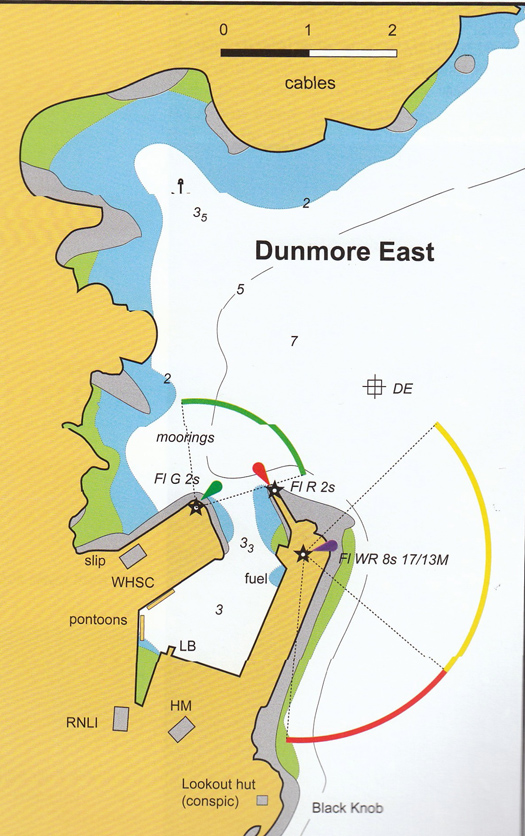
Dunmore East's substantial pier was new-built originally to provide a port for cross-channel sailing Packet Boats, serving Waterford ten miles up the road. When this was its primary function, any local fishermen were banished to the poorly-sheltered coves to the north, with their boats being hauled up on the exposed beaches beyond. Plan courtesy Irish Cruising Club
Soon, however, steam driven packet boats were able to go conveniently all the way up to Waterford, and Dunmore East was redundant as a packet-boat harbour. But it was only with reluctance that fishing boat were allowed to start using it, as the Royal Navy would have been keeping an eye on its possibilities for their own occasional use.
Yet down the years, the idea has developed that Dunmore East was always primarily a fishing harbour, and to a lesser extent the same attitude prevailed at Howth on the east coast, where the new harbour functioned as the Packet Boat station for Dublin only between 1817 and 1826, when the developing new asylum harbour at Dun Laoghaire became the selected port for the Royal Mail's new paddle steamers serving the cross-channel route. Yet the silted harbour at Howth was only allowed to become a "fishing station" in the 1850s.
The legacy of all this, in Dunmore East at any rate, is that there still seems to be a suspicion among the fishing community that their tenure is only temporary, that the powers-that-be would move them out if they see a better use for the place. How else can we explain the negative and almost paranoid attitude of the fishing spokesmen every time a suggestion for a much-needed marina at Dunmore East is put forward?
With all this in mind, I made a quick visit to Dunmore East in mid-August while on other business in the southeast, in the hope of seeing if a much-trumpeted €4 million dredging scheme was now in progress in the harbour, and also to see how an equally celebrated new Visitors Pontoon along the East Pier was working out.
The photos speak for themselves. There wasn't any sign of a dredger, though doubtless that will turn up in due course. Yet as for the 40 metre pontoon, it's not a leisure-boat-friendly neat little piece of work at all, but is quite a massive and brutal steel box structure more suited to rugged fishing boats, who were showing their approval by using it so totally that the only leisure visitor was a German motor-cruiser which had managed to squeeze in at one end.
But as this pontoon is on the wrong side of the harbour for ease of access to the Sailing Club on the west side, and the welcoming facilities in the village above it, any pedestrian boat visitor – the vast majority of incoming leisure boaters, in other words – has a long trek through the sometimes crowded and malodourous delights of a fishing port before they can access any amenities. So not surprisingly the German boat had its inflatable tender moored outside it for quick and easy movement across the harbour, and along to the beaches if wished, a situation which inevitably precluded any other newly-arrived boat from rafting up alongside
So for any cruising boat coming in from sea, often with the challenge of Hook Head just recently put astern, it wasn't a welcoming setup. In fact, it was downright hostile. While we were there, an ordinary sailing cruiser with happy folk aboard came motoring from the eastward to round the end of the pier after stowing their sails, but their hopes of a convenient and enjoyable visit to Dunmore East were soon dashed. No welcoming RIB came out from the sailing club to direct them to a vacant mooring, as there probably wasn't one. And as for the pontoon, "unwelcoming" is inadequate. It clearly didn't want anything to do with them. You could see their spirits wilting as they headed out, faced with the long haul up to the marina in Waterford City. The current visitor berthing situation in Dunmore East is at the very least a sad business, so where does it go from here?

Dunmore East in mid-August. No sign of any dredging, and the "Visitors Pontoon" under the lighthouse on the East Pier is packed out with fishing boats.......Photo: W M Nixon
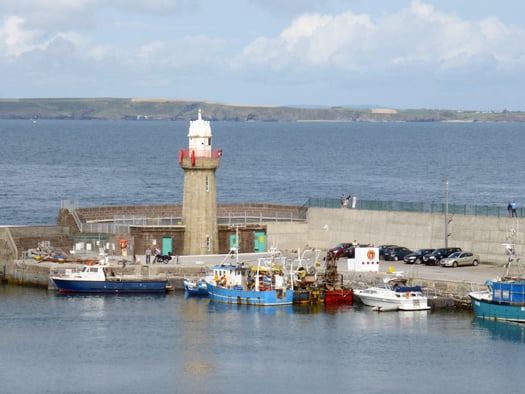
........and just one visiting German motor cruiser which was protected against any rafting up by its tender on the outer side. Photo: W M Nixon

The new pontoon is an industrial standard piece of kit......Photo: W M Nixon
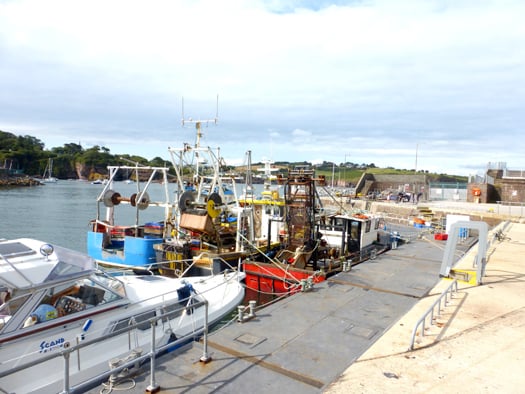
....and understandably very popular with active fishing boats. Photo: W M Nixon

But for visiting sailing boats newly arrived in port.......Photo: W M Nixon
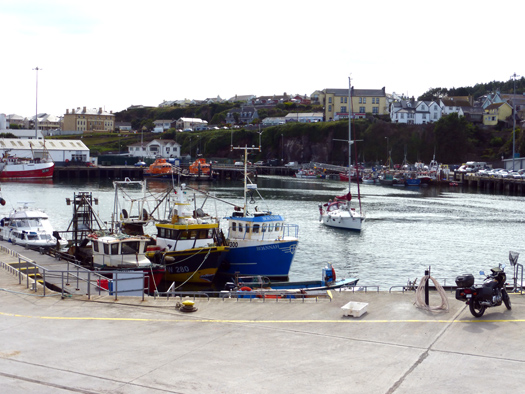
....it's soon clear that there isn't really a welcoming berth for them.....Photo: W M Nixon
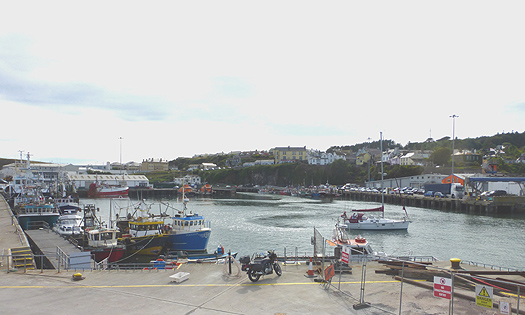
....and they head out to sea again, visibly disappointed by their Dunmore East welcome. Photo: W M Nixon
The Sailing & Boating Wonders of Ireland's West Cork Coast
The sailing paradise of West Cork on Ireland's south-west coast is at its best right now, and the south coast fleets are already heading that way for the traditional West Cork regattas in August. WM Nixon reflects on the magic sailing region of West Cork.
West Cork is as much of a frame of mind as a specific place. Officially, we might suppose it to extend all the way along the Rebel County's coast from the Old Head of Kinsale to Dursey Island away in the far nor'west, up at the north side of the wide entrance to Bantry Bay. But this doesn't necessarily mean that all the folk in the hinterland north of this coastline see themselves as being in West Cork.
As for boat people, our limits are much more narrowly defined. If you're afloat down there, West Cork is that sublime but compact bit of coastline between Galley Head and Mizen Head, just 38 miles as the gannet flies. It's the ultimate lotus land, with an interesting scattering of islands, blessed moreover with an abundance of sheltered natural harbours each with its own port town or village vying with its neighbours in colourful character. And visible from much of it is the Fastnet Rock, mysteriously a place of the remotest ocean despite being only a matter of four miles from the nearest land at Cape Clear.
In this magic land, the local mini-capital is of course Skibbereen, the very essence of a rural market town. But on the coast, the very different harbours of Schull, Baltimore, and sometimes even Glandore have been seen over the years as the sailors' capital of West Cork. Recently, however, it is Baltimore which has gone from strength to strength to affirm its position as the sailing capital of the southwest, and spending a June night there as summer settled comfortably over Munster reinforced the impression of its pre-eminence.
We were on a bit of a land cruise, so the bed for the night was in the Waterfront, the hotel where Room 12 is just about as near to the beating heart of Baltimore as you can get. Aboard a cruiser in Baltimore, you can enjoy that splendid isolation which a boat so easily confers. But in Room 12 on top of the Waterfront's northwest corner above the square, the busy life of the little port town bubbles about you, and the views across to Sherkin Island and over the country to Mount Gabriel get even more perfect with the approach of sunset.
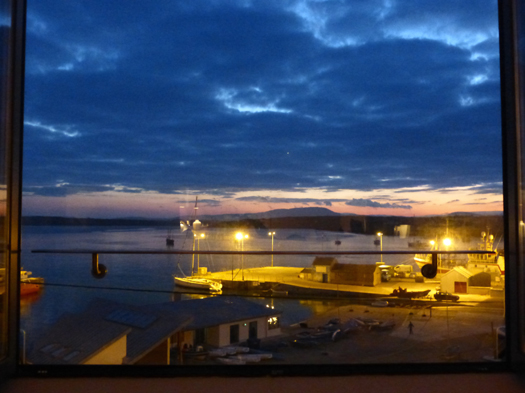
The view from Room 12 at the Waterfront in Baltimore. The sun has set beyond Mount Gabriel, but somebody is busy launching a newly-arrived RIB by floodlight, and the buzz from the square below is still rising. Photo: W M Nixon
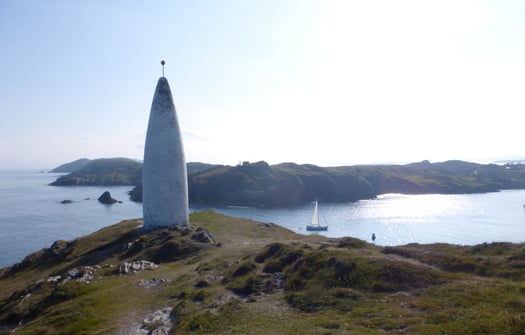
It has to be one of the best arrivals in world sailing. A cruiser enters Baltimore beneath the Baltimore Beacon, aka Lot's Wife. Photo: W M Nixon
It was fifty years ago when I first sailed in to Baltimore, coming in from the west on a round Ireland cruise, and entering port close under the beacon – Lot's Wife they call it – to find a quiet little place which showed some signs of a former prosperity, and hinted at better times to come. Back in 1964, it still had its railway station, but the West Cork Line was in its final year and was soon to be totally closed. Before that happened, later that summer when Baltimore Sailing Club hosted Dinghy Week for the Irish Dinghy Racing Association, the Firefly Class in Dun Laoghaire – mostly university boats – had been able to have a Tuesday night race. Then they'd towed their boats into Dun Laoghaire station on the launching trolleys, put them onto a CIE flat truck, and found them on Friday night safely delivered by rail the entire way to West Cork, offloaded ready at the harbourside station in Baltimore, and waiting for the arrival of thirsty crews keen for a bit of sport.
Mostly, they'd got themselves there by overloading some little car belonging to somebody or other's mother, so the fact that they disdained to use the railway themselves would help to explain why such a charming amenity was doomed. Since then, of course, Baltimore Railway Station from 1969 until recently had become Ireland's first Glenans base. But life moves on, the Glenans model doesn't seem to work any more in Ireland, so now the former station is for sale by the powers-that-be, and there are ructions being raised about it all which should keep everybody nicely exercised through the rest of the summer.
It was another French import which currently sets the pace in Baltimore. Around 1980 a young Breton fisherman, Youen Jacob, came into the harbour, and in time he settled there. To say that Youen Jacob has played a major role in Baltimore life is understating the case. It is he and his family who have developed the Waterfront – quite a challenge in somewhere as conservative as West Cork – and with Youen Jnr's Jolie Brise restaurant and guest house beside it to provide an alternative aspect of good Breton cuisine, the Jacob family's establishments have given a healthy new configuration to Baltimore's miniature harbourside square, and have settled in so well you could be forgiven for thinking the little town was built around them.
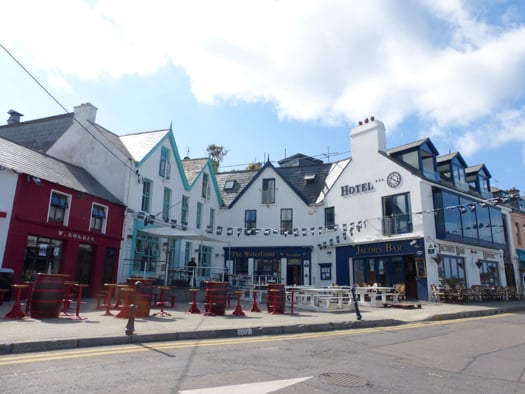
The Waterfront (right) and Jolie Brise at the south side of the mini-square in Baltimore bring a welcome breath of Brittany to West Cork. Photo: W M Nixon
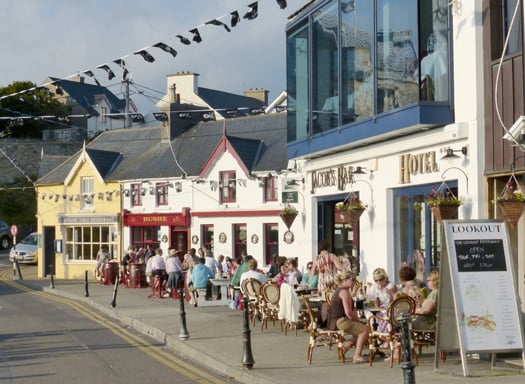
It's party time in Baltimore. The al fresco lifestyle is expected in West Cork in summer. Photo: W M Nixon
There are times when you'd understandably think this is the hub of the maritime universe, and why not? But if, during a quiet cruise, you think you might find it too hectic at night when the joint really is jumping, the sensible thing is to call by at lunchtime when everybody is out at the islands and Baltimore is refreshed and catching its breath for the next night's partying. Then in the evening, you can pop over to Sherkin Island where peace will reign while Baltimore ramps up the socializing.
Up in our eyrie above the square, we savoured the life of this busy little port. It's not quite a 24-hour town, but late at night boats were still being launched by floodlight, and conviviality continued in the square. Finally, peace descended, and though most folk were slow to stir early in the morning, the first ferries were coming in, and a workboat headed out for the islands, going past Graham Bailey's Peel Castle, the remarkable bisquine-rigged variation on a 50ft 1929-built Cornish lugger which is seen at her best on her mooring in Baltimore harbour. This is only right and proper, as the restoration and re-configuration of Peel Castle took place nearby, just up the Ilen River at one of the boatyards at Oldcourt.
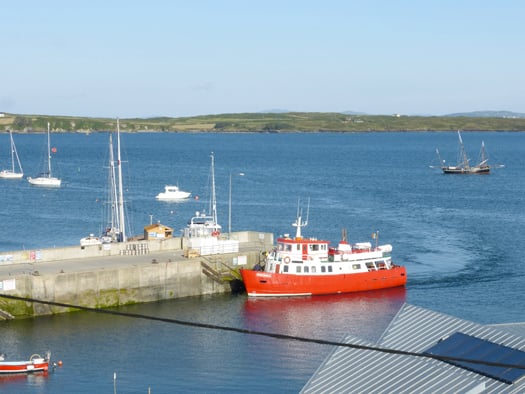
Good morning Baltimore, how are you? The first ferry arrives in from Sherkin Island. Photo: W M Nixon
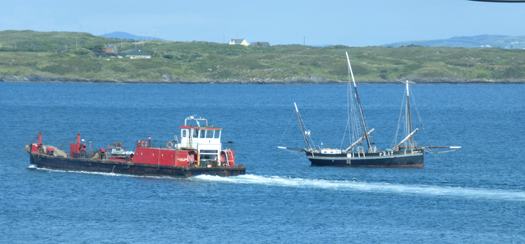
Getting the day's job started. A workboat heads out towards Sherkin past Graham Bailey's distinctive Peel Castle. Photo: W M Nixon

Peel Castle in all her glory in the middle of Baltimore Harbour. Restoring this 1929-built 50ft Cornish fishing boat and giving her a bisquine rig took Graham Bailey eight years of dedicated work at Oldcourt. Photo: W M Nixon
Another Baltimore revival which gets our approval is the restoration of the castle right in the middle of town, the "tigh mor" which presumably gives the place its name. We suffer from a widespread ruins overload in Ireland, so it's refreshing to find that somebody upped and took action, brining a ruin back to life and giving Baltimore a very effective signature focal point with a useful function. You could do the same to good effect at Dromineer on Lough Derg, where the ruined castle is an eyesore.
But you don't even have to leave the Baltimore area for a worthwhile restoration project, as just across the harbour beside the pier on Sherkin is the roofless ruin of the 15th Century Franciscan friary which we know looks much better with its roof back on, even if it has been missing since the 1770s.
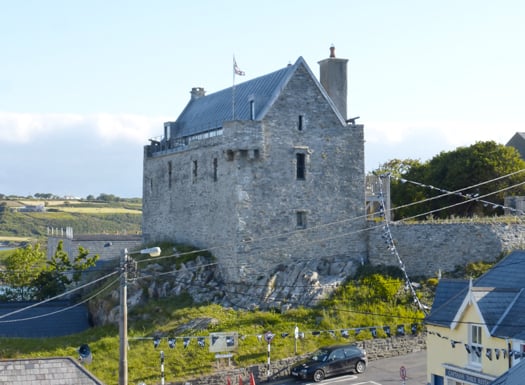
The restoration of the castle at Baltimore has given welcome and useful new life to a former ruin. Photo: W M Nixon
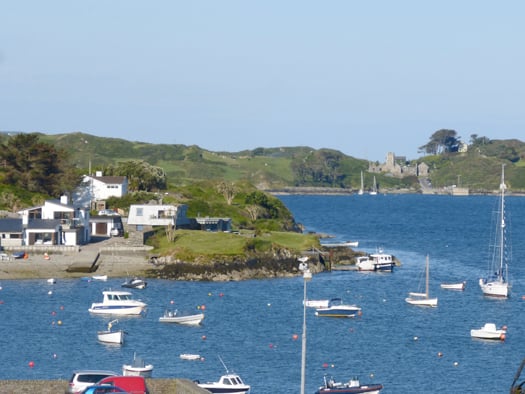
The Cove on the south side of Baltimore Harbour has some very desirable real estate. Photo: W M Nixon
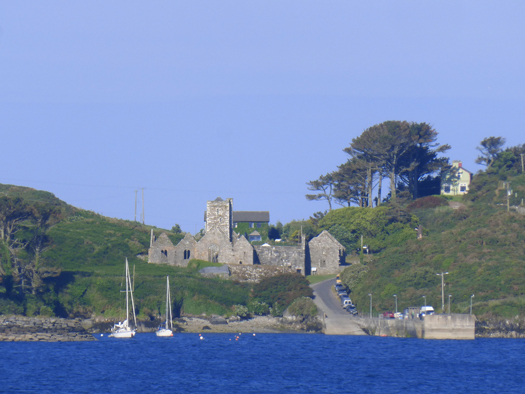
Thanks to its use as a film set in 1973, we know that the friary on Skerkin Island looks much better with it roof in place. Photo: W M Nixon
We know this because, in 1973, the makers of a TV film managed to get permission from the OPW to put a temporary but very convincing roof in place, and it looked so utterly right. The film was the unfairly forgotten Catholics, based on the novel of the same name by Belfast-born Brian Moore, and memorably starring Trevor Howard as the troubled Father Abbot. Even in this usually overlong blog, there isn't space to go into the details of the story, but it's worth viewing Catholics at the very least to see how well Sherkin friary looks with a roof. Alas, when filming was done the production company religiously (how else?) adhered to the OPW's demands to return the very attractive little old building to its ruinous state, and there it sadly sits.
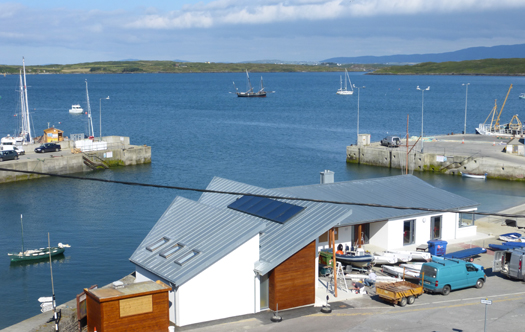
This year's work on Baltimore Sailing Club has made it even more of a local asset. Photo: W M Nixon
But as regular readers of Afloat.ie will know, other refurbishment and extension work has been under way in Baltimore, with the Sailing Club in fine fettle in its extended premises which look so well you'd think it's all new. It's certainly all of a piece with Baltimore's vitality, which contrasts with other little West Cork ports. In Baltimore, the key to it all is the fact that the Waterfront gallantly stays open all year round. But at present in Schull and Glandore, the main hotels don't even open in summer.
Doubtless in time, and sooner rather than later, both establishments will be brought back to life. But for people genuinely cruising, the absence of a hotel or two doesn't matter that much in an area where the abundance of cruising options and hospitable pubs with good food is almost bewildering. And around Baltimore in particular, there's always something going on.
The wholesome 1893-built cutter Eva (later known as Guillemot) was restored at Oldcourt, which is only a few miles from her birthplace 121 years ago on the Baltimore waterfront. Brian Marten's project to have Eva re-born and continue as Guillemot has come to a successful conclusion after she went through several vicissitudes before he happened upon her, but a visit to Oldcourt will reveal many other boat restoration, re-build and re-birth projects at various stages, including some which - as our accountancy friends would insist on putting it - are no longer going forward.
Be warned, however, that any visit to Oldcourt in any capacity whatever is likely to take longer than you expect, as there's simply so much to see. And they're at every stage, from projects just starting, through projects stalled, to projects nearing completion, while inspiration was being provided by a visiting boat, Darryl Hughes' immaculately-restored 1937 43ft Tyrrell ketch Maybird, which was berthed for a while at Oldcourt to let boatbuilder John Hegarty take off measurements in order to build a traditional clinker dinghy which will fit on board.
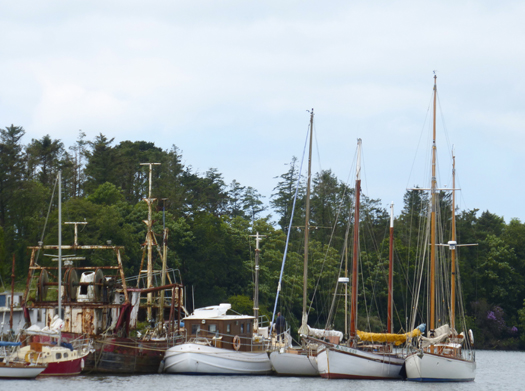
Boats in a row at Oldcourt. The further from the quay, the more ready for sea you are. Furthest out is the 1937 Tyrrell ketch Maybird, with which owner Darryl Hughes regularly attends the annual Yeats Summer School in Sligo. He's the only participant to arrive by sea, and he lives on board at the pontoon in Sligo during the Yeats festival. Photo: W M Nixon
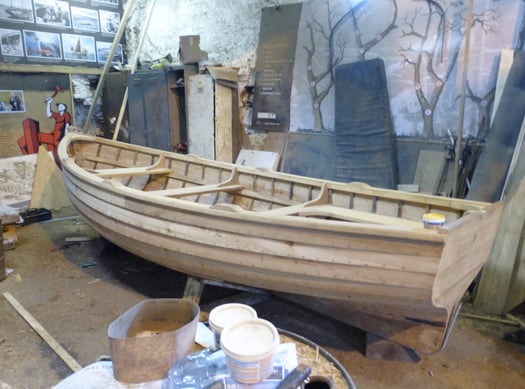
A new traditional clinker dinghy, built by John Hegarty of Oldcourt, awaits her first coast of varnish. Photo: W M Nixon
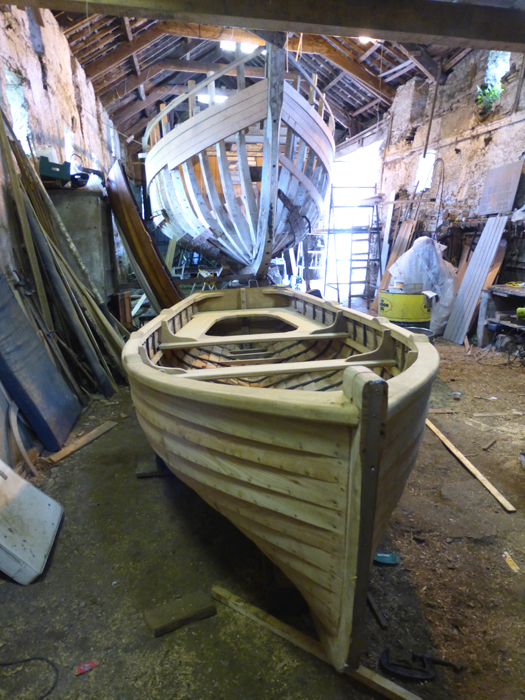
The new dinghy shares space with Conor O'Brien's Ilen, which continues to be a major work in progress. Photo: W M Nixon
Just to show what the result will be like, there was another recently-completed Hegarty dinghy in the Ilen shed, and very well it looked too. As for the restoration of Conor O'Brien's Ilen herself, that can best be described as ongoing. It has become such an absorbing task that the restoration process might best be thought of as an end in itself. Trying to work out what could most usefully be done with this hefty big lump of a boat if she ever is restored to seagoing condition is something which will require many brainstorming sessions, but it surely doesn't need to be considered in too much detail just yet.
The problem with the Ilen is she's too small for some things, and too big for others. She's of the same sort of in-between size which made the first Asgard of limited use as an official sail training vessel. Asgard was fine for teaching young people to sail, but she was simply too small to keep up with the tall ships which also completely overshadowed her in port, where Ireland's little ketch also failed to provide the necessary space and impressive setting for entertaining local bigwigs.
Manageability is the keynote to successful boat restorations. But Oldcourt is such a maritime universe that it can provide examples of what you'd think might have been eminently manageable restoration projects, yet they've ground to a halt. One such is Englyn, the creme de la crème of the boats amateur-designed by Harrison Butler, the English opthalmologist. In the 1930s, he was designing boats which successfully anticipated the highly-regarded designs of Lyle Hess more than forty years later, and the 26ft 6ins Englyn was so highly thought of by cruising guru Eric Hiscock that he included the design in his seminal book Cruising Under Sail, first published 1950.
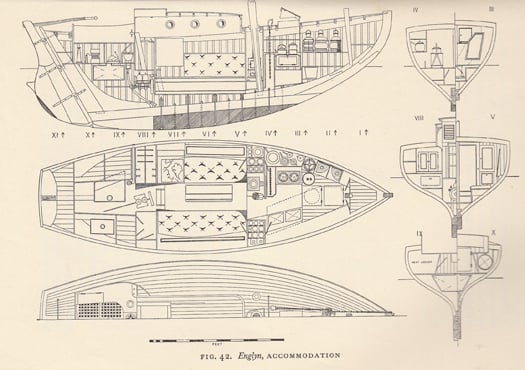
Plans of the Harrison Butler-designed Englyn, as featured in Eric Hiscock's Cruising Under Sail.
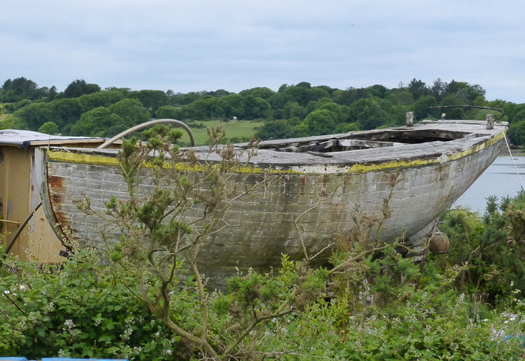
A little boat that may have missed the boat. Englyn as she is today. Photo: W M Nixon
If anything, the designs of Harrison Butler are more cherished than ever, and in this blog on May 10th we featured photos of the Harrison Butler Khamseen class cutter which ace boatbuilder Steve Morris is creating near Kilrush. It's heart-breaking to see the lines of Steve's healthy boat palely reflected in the weather-beaten remains of Englyn as she is today. But sometimes boats really can be brought back from the near-dead, and at the two-day Glandore Classic Boat Summer School in mid-July, the entire Sunday afternoon was given over to presentations about boats in various stages of restoration in and around Oldcourt.
Despite some unpleasantnesses visited upon it by the lingering death of the Celtic Tiger, Glandore gallantly soldiers on. Glandore Harbour Yacht Club's new headquarters in a cleverly rebuilt two-storey cottage up a side street (the only side street, as it happens) is appropriate to the good taste which prevails in this sweet place, whose name in Irish can mean either the golden harbour, or the harbour of the oaks - either will do very nicely.
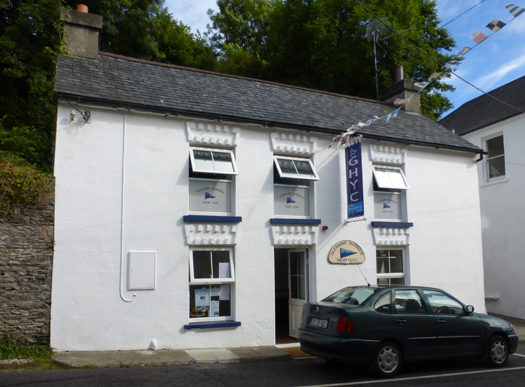
Glandore Harbour YC's clubhouse is now this cleverly re-built two-storey cottage beside the harbour. Photo: W M Nixon

The outboard dinghies waiting at the pontoon at Glandore Pier give a good indication of the number of boats based in Glandore and across the harbour at Union Hall. Photo: W M Nixon
The Summer School packed in an extraordinary variety of topics, and even this blogger was wheeled out to develop his thesis based around the ambiguous question: Why shouldn't the Irish be a seafaring people? Don't worry, for those who missed it, we'll push it out again here some time in the depth of winter. But we cannot hope to convey the full wonder of the best event in the Summer School, the question-and-answer session between ocean voyaging and offshore racing legend Don Street and his son Richard.
The old boy hasn't half been around. And if at some time your only experience of Don Street has been a high-pitched New England rant about some iniquity of modern yachting (fibreglass dismissed as "frozen snot", for instance) it's my happy duty to assure you that, as he delved into his extraordinary memories, the pitch of Don Street's distinctive voice became deeper and more resonant, until by the time he concluded all too early, we could have been listening to Captain Ahab himself.
From such a treasure trove of recollection, there were many gems, perhaps the best being about how he came to make his profession in writing about the sea and sailing. In his early days in the Caribbean before he'd put pen to paper, on one run ashore Don and his shipmates met up with Nobel Laureate John Steinbeck, and they'd a convivial time together. Later, heading back along the islands, they'd another dinner with the great writer, and during yarning at table, Don's shipmates insisted he'd so many good stories to tell that he should write them down.
"But I don't know how to spell, and I know nothing about grammar" complained Don.
"But you've a story to tell" said Steinbeck, "and you tell it well. Just you write it down, and the editors will sort out the spelling and the punctuation and the grammar. That's their job."
God be with the days......
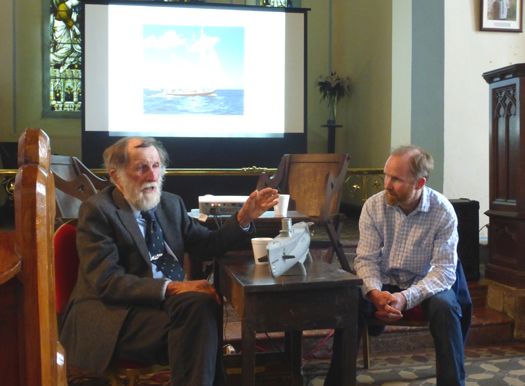
The old man of the sea – Don Street's reminiscences were the highlight of this year's Glandore Classic Boat Summer School. The school sessions were held in the harbourside church, and Don is seen here with his son Richard while he recalls his days in submarines in the US Navy. On the screen is his legendary 1905-built yawl Iolaire, in which he cruised the Caribbean and crossed the Atlantic. Photo: W M Nixon
Facing Up To Irish Sailing's New Realities
#irishsailing – Ireland is having a busy sailing season through 2014, but there is concern about the decline in turnouts in some major events. W M Nixon suggests that, during the years we've been pre-occupied with weathering the economic storm, we may have missed the fact that the basic structure of sailing is changing.
We've lived through interesting times, these past few years. And with Ireland's particular woes during the global financial crisis, the general lack of money and resources, coupled with the decline in simple enthusiasm for living energetically and enjoying participant sport, has obscured the fact that sailing – like most sports – has been changing, with an increasing emphasis on focussing attention on a few big professional events, rather than celebrating the small and the local.
A clear case in point was the visit of the Clipper Race to Derry/Londonderry, which coincided precisely with the weekend at the end of June when the biennial Round Ireland Race was staged from Wicklow. Although there were many entries racing round Ireland which had varying levels of what we might call soft sponsorship, essentially it was an unsponsored race for amateurs run by amateurs, something to which the mass media will give little if any attention.
But the Clipper Race by contrast is now a firmly established commercial venture based on a sound business model. Robin Knox-Johnston has certainly earned the event's success with his dedicated promotion of the ideal over the years, and the main sponsors – whether they be major brands, cities, regions or even countries - feel very comfortable with it. This is a corporate affair where all the big decision makers can be confident that there'll be a highly professional output of good human interest news stories. And if a television company sends down a film crew with a reporter to cover the stopover, the Clipper Race's own people will know exactly what they need, and thereby maximise their expensive time to produce newsworthy results.
As for the non-professional paying crews taking part, they're fully aware that they've divvied up the kind of money which would buy them their own very useful little boat if they so wished, and have a bit of money left over to run it too. But they much prefer to pay up front for what they know will be the sailing experience of a lifetime, all neatly packaged and ready to go, and everything done and dusted at the and of it.

Derry/Londonderry/Doire arrives at the entrance to Lough Foyle to win the Clipper Race's Transatlantic leg.
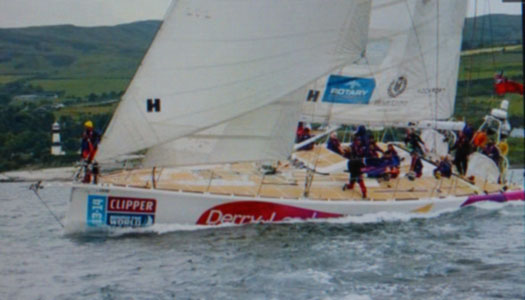
Home to victory – DLD making knots up Lough Foyle past the coast of Donegal
When the various pay-up-front round the world races were establishing themselves several decades ago, one noted newspaper sports editor famously agreed that they were the sporting equivalent of a fleet of tour buses full of paying passengers racing down the road from Dublin to Killarney. My own feeling was that a tour bus race would actually be great fun, but I could see the point that it was remote indeed from the purest concepts of sport.
Nevertheless the round the world operators have been whittled down over the years until the Clipper Race not only survives but actually thrives mightily, and has an image to die for. Far from being a specialised oddity, it is becoming mainstream. In Australia, the annual Sydney-Hobart Race struggles each year to get its entries above the hundred mark, so when the Clipper organisers suggested they might make Sydney-Hobart 2013 a leg of their course, the organisers – the prestigious Cruising Yacht Club of Australia – leapt at the chance. And as far as we're concerned in Ireland, it was a great success, as the Irish boat Legenderry, skippered by Sean McCarter of Donegal, was the winner of the Clipper division, while it was noted with added satisfaction that his hefty big "tour bus" had by no means been beaten by all the fancy out-and-out racing machines sailed by Hobart race veterans.

Sean McCarter aboard DLD – his class victory in the Sydney-Hobart Race made him the Afloat.ie "Sailor of the Month" for January.
But even in the best of all possible worlds, there is only so much in the way of resources for such events, and public attention is very limited and fickle. Yet in the end, public attention is what motivates sponsorship. For sure, in a small, specialised and intensely personal sport like sailing, there will always be a willingness by some company bosses to give a bit of help to a friend organising a sailing event. But at the very least it has to be something which can in some way be justified on the balance sheet, and with the increasing dominance of the ubiquitous accountant, and his or her need in turn to justify aspects of the company's behaviour to the tax inspectors, the old "helping out a mate" approach to sailing sponsorship becomes increasingly difficult to justify.
Yet although almost all sailing enthusiasts will give a bit of their attention to events like the Clipper Race and the Sailing Olympics, while even the most hidebound traditionalist will occasionally take a furtive note of what's going on in the snakepit of the America's Cup, the fact is that for most of us, sailing is still primarily a matter of sailing our own boat, or crewing with old shipmates on someone else's craft, and taking part in club racing and local regattas which to us are the essence of the sport.
But in terms of outside attention, even in the town or village attached to our own home ports such beloved sporting activity scarcely registers at all in a world in which round-the-clock sporting highlights are available on the media or in a nearby stadium virtually all the time.
Most of Irish sailing is all about what Edmund Burke called "the little platoons". While Burke recognised the inevitable and growing power of the big battalions, he promoted the ideal of the vital function of the little platoons – basically the family unit, the extended family, and their circle of friends – in holding society together and preserving civilised life.
So instead of mindlessly banging the drum about Ireland being a great place to sail, and endlessly repeating the mantra about the Royal Cork being the world's first proper yacht club – true and all as both may be – perhaps it's time to be realistic about our sailing situation, cherish what we have, and thereby build it to a healthy state.
Admittedly if you go overboard on being realistic, you can quickly become pessimistic and reduce all home sailing activity in recognition of the fact that many people's sailing ideal is a warm and sunny fortnight in Croatia or the Greek Islands, sailing boats whose care and maintenance is someone else's responsibility, and sailing moreover on waters which won't give you hypothermia after an hour's immersion.

The legendary American offshore racer Carina rounding the Fastnet Rock in the race of 2011. Carina will be one of many contenders in the Fastnet Race of 2015, but like most of the large fleet, it's unlikely she'll enter any Irish port.
But the perception elsewhere is that Ireland is quite a rugged place to sail. In fact, for many who briefly sail in our waters every other year, the ruggedness of our waters is the USP of the Fastnet Race. The biennial Grand National of offshore racing is now the epitome of a "big battalions" event. With the added kudos of the 1979 disaster in its history, having a Fastnet Race in your sailing CV is a globally-recognised distinction. Thus we can be quite sure that next year's race will see the enormous but limited entry list filled almost instantly, and equally we can be sure that the Irish economy will scarcely benefit at all from a huge event which uses our most iconic rock as the main mark of the course, the very symbol of an entire vast international event, yet the race starts and finishes in the south of England.
As to the perception of Ireland's weather and our sailing conditions, ten days ago I was up at Ballyholme Bay on Belfast Lough for the annual F18 World Championship. The F18 is a hugely popular catamaran which thrives as a class where sailing waters are in easy reach of large populations. Thus its biggest fleets are along the north and northwest coasts of France, but it's big in Holland and Germany too, and in the south of France and Italy it prospers mightily.

Belfast Lough produced some fine Irish summer sailing weather for the F18 Worlds, and at the same time the F17 Worlds in the south of France were being disrupted by severe gales. Photo: W M Nixon
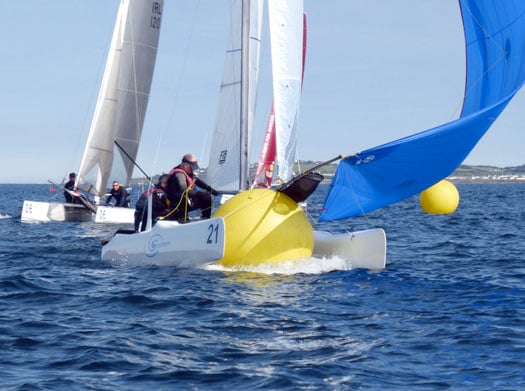
Whoops....it may have been a World Championship, yet there were some very human errors. But then, anyone accustomed to sailing a monohull could very easily forget you've a second hull to lee. Photo: W M Nixon
The 2013 Worlds in Italy attracted a fleet of 170 boats with thousands attending the opening festival. Then, as the well-run class has a policy of rotating the Worlds around countries which have a significant presence of F18s, the fact that it's the biggest catamaran class in Ireland saw the 2014 Worlds allocated to Ballyholme, Northern Ireland's premier dinghy club and a stronghold of F18 racing.
They knew that it would be wildly optimistic to expect a fleet to match Italy's lineup of 170 in 2013. But a target of a hundred boats seemed reasonable. Yet in the end they got 56. They'd great racing – much better than their smaller sisters the F17s which were being blown out of the water at the same time at their Worlds in the south of France. And with Gunnar Larssen of the Netherlands winning the title at his 13th attempt, there was a popular winner for a keen class of very pleasant people who were interesting and fun to be around.
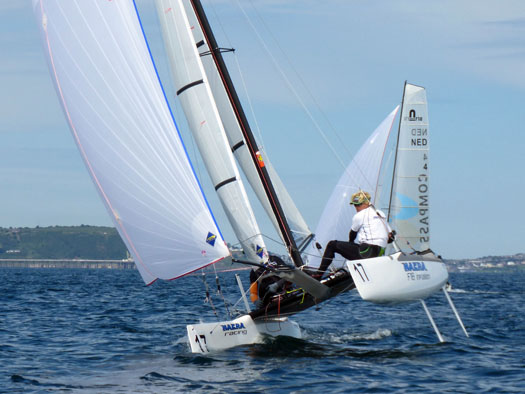
The F18s can be powered up in light breezes if you can get the weather hull clear.........Photo: W M Nixon

....and as the breeze builds, the hope is to have both crew on the wires......Photo: W M Nixon
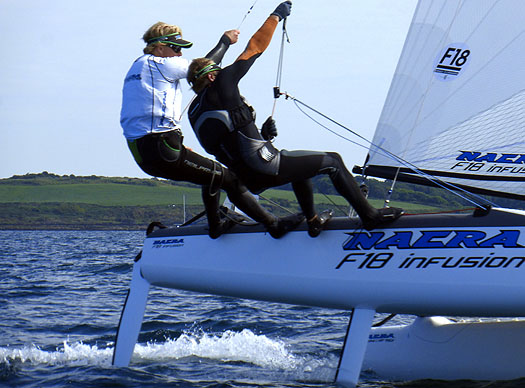
.....and then you're really cooking with gas. Photo: W M Nixon

It can be a knife edge. This may all look very relaxed, but it happened in jig time. Photo: W M Nixon
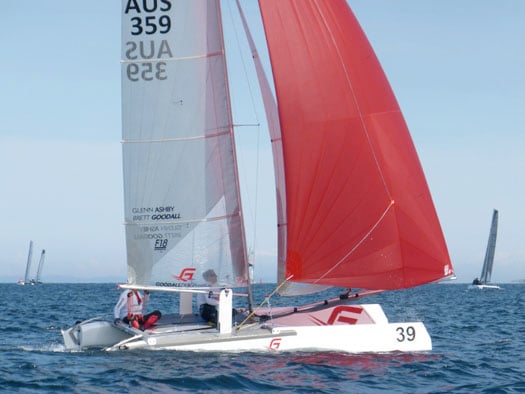
America's Cup rockstar Glenn Ashby of Australia was in the frame from time to time, but boat damage hindered his campaign. Photo: W M Nixon
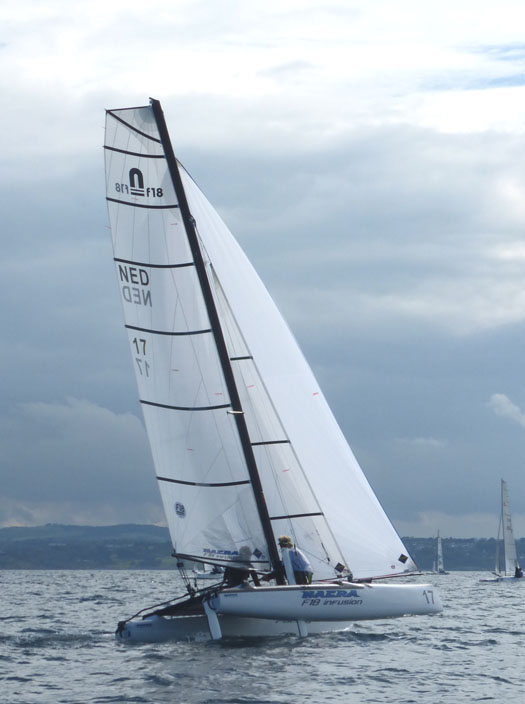
Despite his Viking name, new F18 World Champion Gunnar Larssen is Dutch. Here he gives a masterclass in winning out on a dead run (yes folks, this IS a dead run, but F18 style). Photo: W M Nixon

It was as the fleet came ashore that you realised the international nature of the entry. And the weather was Mediterranean, while in the Med itself, it was blowing a gale.....Photo: W M Nixon
As for a fleet of 56, it's more than enough to provide good sport, and they certainly had it. But it was a chilling – in every sense – reminder of the fact that, ever since Roman times, Ireland has been seen by the rest of Europe as Hibernia, the Land of Eternal Winter, and thus for the modern sailing world in general, we're seen as a small and distant island where only the most rugged would dream of going upon the sea.
Perhaps the turnout in any international event here could be directly calculated in relation to the distance of the venue from Mediterranean sailing conditions, qualified by the distance from Europe's main population centres. And lest anyone think that this compact turnout at Ballyholme was essentially to do with the special circumstances of Northern Ireland, at exactly the same time Cork Week saw numbers hovering around the hundred mark. And this in an event which fifteen years ago used to soar above five hundred.
It's a forceful reminded of how our sailing times are changing. If something is going to be very big in every way, then it can take up a lot of time and energy. But the old days of private owners divvying up resources and chivvying up crews in order to do a distant medium size regatta with all its logistical challenges seem to be a thing of the past, as the Scottish Series has also been finding out.
Yet if you visit every corner of Ireland, you'll be pleasantly surprised to find that on every coastline, any good anchorage is well filled with boats. After six years of economic stagnation, they may not be the newest boats around. But they're there in apparently greater numbers than ever, and they function happily in a strictly local environment.
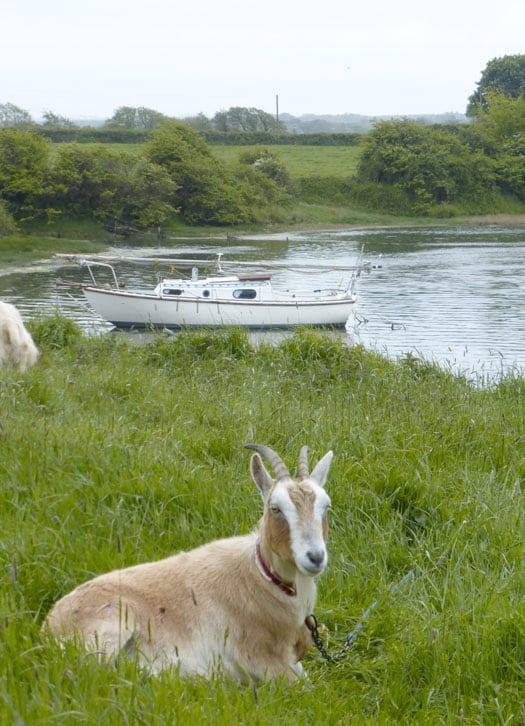
Ireland's hidden fleet (1). While getting a snap of this splendid goat at Ballylongford on the Shannon Estuary, we found our photo included a Macwester sloop, part of the growing local fleet in this remote inlet. Photo: W M Nixon
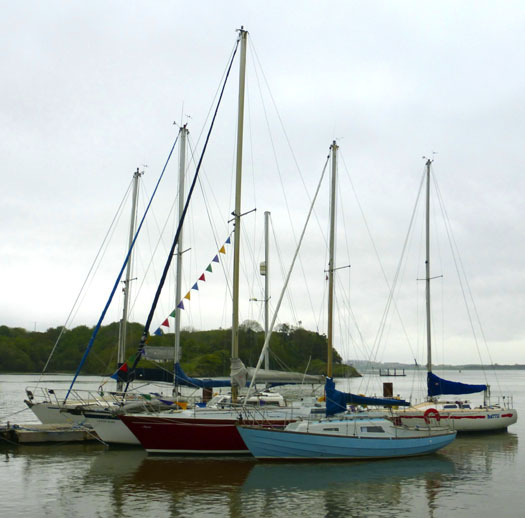
Ireland's hidden fleet (2). The cruiser-racers at Foynes YC have steadily increased in number for several years. This group includes two Irish-built boats on the right: an O'Brien Kennedy-designed Kerry, and a Ron Holland-designed Shamrock. Photo: W M Nixon
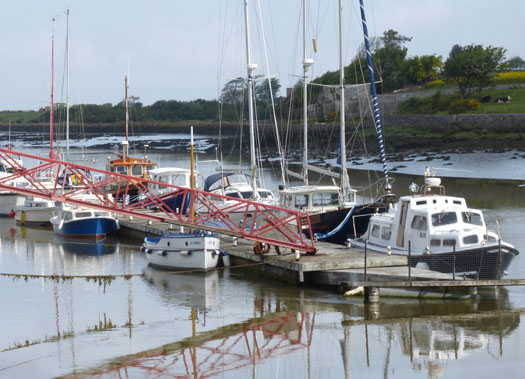
Ireland's hidden fleet (3). Up and down the Shannon, everyone will know of Askeaton in County Limerick, and Cyril Ryan's busy boatyard there. But who in the big outside world knows that this muddy creek is home to a fine fleet? Photo: W M Nixon
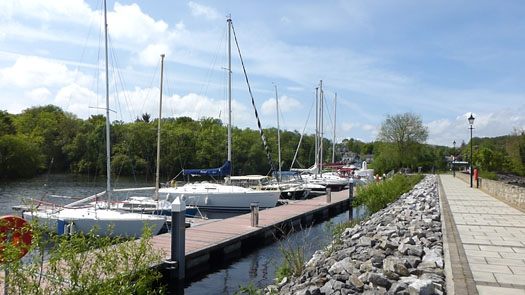
Ireland's hidden fleet (4). Talk of sailing on the Shannon lakes, and most folk will think of Lough Ree YC or Lough Derg YC, plus Iniscealtra SC at Mountshannon, and that's about it. But the extended harbour at Garrykennedy in Tipperary also has a fine fleet which wouldn't look out of place in a seaport. Photo: W M Nixon
It's something which will never be a headline-hitting sporting sensation, this quiet sailing enthusiasm of the little platoons. But it's there nevertheless, and as economic recovery picks up, who knows but we might be able to build it up into a slightly busier and better-supported sailing programme based on a realistic appreciation of the fact that while we may be a reasonably-sized island – the 30th largest in the world, to be precise – we're sparsely populated, we're relatively remote from the very big places, and we sail in a climate which can be rugged enough.
But as things get moving again, let's be realistic. There are grants available for clubs which wish to expand or develop their facilities. However, the message is: Don't simply think up some wizard scheme just to be able to avail of a grant. Instead, be realistic about what your really club and its membership really needs, and then -further down the line - see if it may be eligible for a grant. Such an approach will be to the benefit of everyone, and will help to build sailing's true image as a participant sport for all who are genuinely interested.
#dunmoreeast – The Minister for Agriculture, Food and the Marine, Simon Coveney TD, today announced details of a €4m dredging project at Dunmore East Fishery Harbour Centre on the occasion of the official opening of a €450,000 renovation of the Marine Leisure Area at the western end of the harbour.
At the opening, the Minister said "I am delighted to officially open this. The completion of this project adds greatly to the Harbour for marine activities generally. This end of the Harbour was in need of revamping for some time, and I prioritised works to make it a fit for purpose amenity which will benefit and promote the marine leisure industry in this area".
Leisure activity in Dunmore East has been increasing substantially in recent years with 180 visiting yachts from all over Ireland and abroad using the harbour in 2013, more than a threefold increase on previous years. Cruise line passengers nearly doubled in 2013 to 9,500 and with the newly renovated slipway it is expected that usage by members of the public will double in 2014 from around 600 in 2013.
The €450,000 renovation included extending the existing slipway, widening it from five to twelve metres, resurfacing and generally improving vehicle and pedestrian access, the development of a promenade with street lighting, improved access to the beach, and a rock armour embankment to protect the development from severe weather conditions.
Commenting on the works the Minister said "This is an excellent piece of infrastructure and is now a top class amenity which will lend itself to the further development of the leisure industry in Dunmore East, and the spin off that will have for tourism and jobs locally".
Announcing the €4m dredging project for Dunmore East to resolve the impacts of years of siltation in the harbour, which has restricted vessel traffic and made manoeuvrability and fish landings problematic for fishermen the Minister said "This significant investment in Dunmore East from the 2014 Fishery Harbour Capital Programme is an indication of this Government's commitment to the fishing industry in the South East. When complete, not only will the harbour be more accessible to larger vessels, landing times and management will be much improved as will the usability of the syncrolift".
Latest figures indicate that the value and volume of fish landings in Dunmore East has been on the increase for a number of years. Between 2010 and 2013 landings increased by 40% from 8,387 tonnes to an estimated 11,718 tonnes. The equivalent value of these landings went from €13.7m in 2010 to an estimated €17.5m in 2013 an increase of 28%.
The Minister went on to say "Taking account of the increased level of fish landings I am conscious of the need to dovetail the much needed dredging works with the seasonal work patterns of the fishing industry to cause as little disruption as possible. With that in mind every effort will be made to ensure that the works will be completed in advance of the important herring fishery later in the year".
Groundwork for the project is well advanced; a public procurement exercise will be initiated in May, with a view to awarding the contract in time for an August commencement date.
Concluding the Minister said "The development and upkeep of Dunmore East as a state of the art Fishery Harbour Centre, supporting a broad range of marine related activities is and will remain an ongoing process. These two major projects and the recent installation of floating pontoons within the Harbour are part of a long term strategy to deliver on the potential of Dunmore East for job creation for the fishing industry and as a marine leisure and tourist destination".
#catamaran – It's the time of year when any sensible sailor is dreaming of skimming across warm blue water without a care in the world, and feeling at one with the ocean. W M Nixon introduces an organisation which is built around this aspiration, yet has a deeper meaning for Pacific island communities.
An island is both an escape, and a prison. On one side of the coin, it seems to provide the means of getting away from the tedium and pressures of over-crowded mainland life. On the other, you're trapped on it if you don't have some sort of choice and control over your own coming and going.
For most of us around boats in Ireland, the ability to sail to islands is one of the greatest attractions in what we do. Sailing to our small islands is pure joy, truly satisfying in a way scarcely justified by the modest distances involved. And being on small islands is a delight. Yet generally we don't want to live on an island year in, year out.
This may seem absurd to those who write off Ireland itself as no more than a small damp island somewhere out in the Atlantic. But for us living here in reasonable content, Ireland is just the right size. It's a complete place, a proper country – that it's an island is almost incidental. We don't really think of it as somewhere you can drive across in only three hours. It's the size it is, that's the way it is, and anywhere else is just unnaturally large.
Probably we actually think of Ireland as a world unto itself – a small but viable landmass which happens to be surrounded by water. So if you want somewhere distinctly different, it's not the obvious one of great open continental land spaces of tundra or prairies or savannah, with unending mountain ranges or trackless tropical forest. On the contrary, the most complete contrast with Ireland is to be found in the Pacific, where the world is almost totally one of water, with tiny islands dotted about at vast distances, some of them with populations so small and remote that they're barely viable communities.
In such circumstances, the people on the islands have traditionally needed to be truly at one with the ocean, embracing it with a natural affinity which meant they were able to voyage long distances in relative comfort with craft which may seem primitive to us. But those vessels too were in harmony with the sea – they didn't battle it, rather they went with its moods, leaving only the lightest of furrows in the ocean astern.

Despite being 73ft long and able to carry a crew of 16, the working weight of these vakas is only 14 tons, and they are easily driven with a relatively small sail area.
The key to it all is the temperature of the sea. When you have an ocean which isn't going to give you hypothermia within an hour or two of immersion, you can voyage on light boats which skim the water. But in our northestern end of the North Atlantic, despite the tail end of the Gulf Stream washing our shores, here in Irish waters we need boats we can be in, rather than boats we're on. We need boats which provide a genuine level of protection from the sea and its punishing cold almost regardless of how we handle them.
So, much as we like to feel we have an understanding with the sea, in some sort of empathy, in fact we're battling with it. Even the surfers who have been putting in such fantastic performances on the west coast in recent days are more akin to bullfighters than sea creatures. It's all about controlling something which is bigger than they, something which arises mightily but then dies and disappears, yet the surfer remains, banging away with his jetski to hit the right spot.
For sure we respect the sea, but as this week's vids of the Safehaven boats being tested off Cork have shown, we aspire to boats which can continue to go about their business almost regardless of sea conditions, while providing complete protection for those on board. Although we may seem to have experienced some overwhelming weather these past few weeks, underlying our attitude is the notion that we know what's going on, that we're in control. It may seem a fine example of human folly and delusion. But the reality is that for most people in what we used to call the West, life is pretty much under control. We live by the clock. Trains, boats and planes leave and arrive pretty much on time. We build and control the machines, and the machines control the world. When disaster headlines erupt, it's only because this comfortable and mechanical state of affairs has been temporarily upset. But normal service is soon resumed.
Set against this powerful certainty, small and isolated island communities in the vastness of the Pacific become fragile. While the elders may live naturally in the old ways and understand the workings of the sea and the necessary regularity and ordinariness of island life, their younger people know only that in the outside world, life is different. There's more readily available entertainment and excitement. There's a wonderful life of machines and timetables. Anyone who can pay the fare can go when and where they please. And huge numbers of people seem very happy with this state of affairs.
So the island becomes a prison, not a paradise, as the old voyaging skills decay. The young people are no long capable of sailing away to distant places as their ancestors did, yet they lack the money to avail of the air travel which is often the only way to get off the island. And the soul of the community, if not actually lost, is sorely troubled. But there are those who feel that while the islands in the sun certainly have to adapt to the dominating realities of modern consumer-oriented life and global communication, they also reckon there's a way in which the old ocean voyaging traditions can be re-jigged to provide a meaningful experience for modern islanders, young and not-so-young.
When that noted solo sailor Sam Davis of Strangford Lough was cruising the Pacific in recent years with his Rival 41 cutter Suvretta, he met up with a group in Tonga who so enthused him that when he finally arrived in our harbour on his way back to Strangford Lough last August, far from talking of his own remarkable voyages, he was almost completely absorbed by talking of the Tahitian Voyaging Society and their fleet of 73ft catamarans.
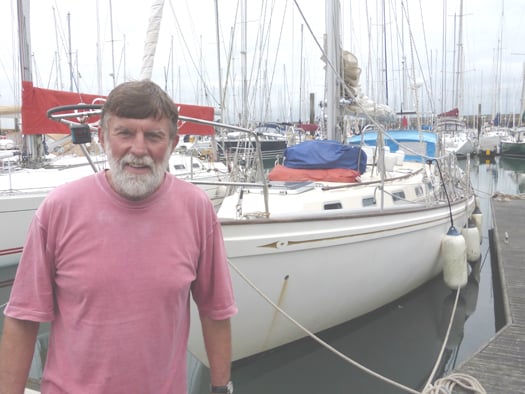
Sam Davis with his much-travelled Rival 41 Suvretta in Howth, August 2013. Photo: W M Nixon
That and mung beans. Sam is into mung beans in a big way. He seems to have lived on them for much of his voyage up the Atlamntic back to Strangford Lough. He was so keen to push the case for mung beans that I didn't have the heart to tell him that in our house we eat little else, apart from the occasional potato and some porridge. So he gave his sermon on the beans, and then we got back to the boats.
And what boats they are. Everything about them is seductive – the way they sail, and the places they sail to. These are not brutal boats of the modern world which rely on ballast keels and high tech engineering and large auxiliary engines. Though their hulls are fibreglass, they are as simple as possible, relying on wind and solar power, and leaving no trace as they sail sweetly across the sea for thousands of miles.
The Tahiti Voyaging Society is the inspiration of German sub-aqua film maker Dieter Paulmann, and in 2011 this remarkable initial fleet of seven 73ft catamarans began voyaging. Three years down the line, they've sailed tens of thousands of miles, and now other islands want to get in on this inspirational programme.
This is where Sam and Suvretta get involved. After wandering to many strange places beyond the seas, they fetched up in Tonga and stayed for some time. Another voyager, Christy Butterfield, the woman boss of a Pacific charter ketch operation, introduced him to her crew – most of whom were Tongan - and then when the big catamarans (the Pacific name is a vaka) arrived in port, they brought him up to speed on what the boats were doing, and how they hoped that Tonga would one day have one if its own, just as places like the Cook Islands, Aotearoa, Tahiti, Fiji and Samoa already do.
The simple life for seafaring. Two of the big cats in port in Tonga, November 2012, with Hine Moana next the quay. Photos: Sam Davis
As it is, Tongan sailors have put in many sea miles as visiting crew on other islands' vakas and one of them - Aunofo Havea – was the first woman skipper in command for a long voyage, sailing the Hine Moana from Tonga to New Zealand. So the spirit is there, the ability is there, all they need is support.
In an Ireland which is currently devoid of any sail training ships north or south, it may seem a bit far-fetched to be voicing enthusiasm for what is in effect a traditional sail training vessel for the Pacific islands. But if you happen to see Sam Davis bearing down on you with a determined look about him, be prepared to take on board an impressive load of information about Pacific voyaging and the vaka programme. And a bit of precautionary research on mung beans wouldn't go amiss either.
#irishcruising – Henry Ford famously said that if he'd started out by asking people what they wanted, they'd have demanded a faster horse. Quite. But if you don't have the lightbulb moment of a Fordian concept so utterly brilliant that it creates its own market, then a bit of humdrum research to find out what the market wants will seldom go amiss.
Encouraging cruising visitors to sail to our coasts provides a good example. Irish sailing has such a long history of its own that it takes an effort to imagine what sailing visitors to our shores are hoping for. But for cruising visitors in particular, if we have to narrow it down to just one aspiration, we'd probably find that they love to go home with a photo of themselves sailing along with the Fastnet Rock in the background.
Better still, a photo of their boat sailing past the Fastnet on a brisk but sunny day, with themselves at the helm – now that really will hit the spot. And then a video of them celebrating afterwards at some nearby and hospitable port over a convivial seafood feast in a characterful inn, accompanied by traditional music - that will do nicely too.
But it's likely many Irish sailors would no more bother to get themselves that Fastnet photo than New Yorkers would go out of their way to be photographed with the Statue of Liberty. It's an attitude which probably lessens the further away from the famous rock you are based in Ireland. But sailing folk familiar with the coast of West Cork will be well aware that the legendary oceanic submerged mountain is actually less than five miles from the pub on Cape Clear, so where's the big deal? You could easily go round it most days if you wished, so why bother to go round it at all? Even Rockabill off Fingal is further from Joe May's in Skerries than the Fastnet is from North Harbour.
But for visitors, getting that Fastnet money shot is a straightforward, achievable and highly-desired objective. And however much the locals on the Irish coast take it for granted, back home in the big population heartlands of Europe or America or wherever, it's quite a trophy for that neighbourhood sailor recently back from Ireland's rugged seas to have on display.
The magic Fastnet photo is also a popular ambition in that it gives a simple objective to any cruise. As Conor O'Brien observed when he took his old boat Kelpie to go off gun-running with Erskine and Molly Childers on their Asgard in 1914, it's good to have a straightforward objective when you go cruising. But possibly a second significant objective for our cruising visitors is to sail round Ireland, even if many of them find the West Coast so awesome once they get there that they linger on it, and return southward retracing their steps, rather than getting home via the "tame" east coast.
Whatever, I'd reckon that these days Irish boats cruising round Ireland are out-numbered by visitors. For visitors, it's a neat objective, and it has all the attraction of going foreign, whereas a crew on a boat from one of Ireland's main sailing centres will have sailed an almost equally arduous voyage to our Atlantic coasts only to find that, thanks to our excellent new road system, they walk into the pub somewhere like Inishbofin, and find the place is filled with people from their home town who came up to Bofin only that morning.
But whether they're from Ireland or abroad, visitors to Inishbofin and other desirable cruising destinations bring a bit of life to the place, and they spend money too. In these straitened times, it makes sense to find out what they expect in the way of facilities to persuade them to stay on and enjoy themselves, maybe tempting them to visit again. Even better, they might encourage others to do so as well, for it's an irony of this supposed age of impersonal electronic communication that word of mouth seems to work better than ever as a marketing tool.

Cruising sociability – gentle West Cork evening of early summer in Baltimore Photo: W M Nixon
So what will make them happy and keen to come? About a year ago, Failte Ireland commissioned "A Review of Tourism Policy Regarding the Development and Funding of Marina and Berthing Facilities in Ireland". The company given the contract – an English consultancy based in the heart of the Solent area with its massive maritime recreational infrastructure – sensibly recruited a comprehensive expert advisory panel from among people in Ireland in the frontline of providing services to those cruising our coasts. Unlike Henry Ford, they'd at least made a gesture to finding out what people wanted. The result is a 68-page document which was effectively completed in December 2012, but is still embargoed. It awaits publication. The mills of Government truly grind slow, and never more so than at a time when, in any case, there's not a red cent available for expenditure on worthwhile maritime recreation infrastructural projects.
So let us pass the time before its eventual publication with a bit of blue sky thinking about the Irish sailing cruising product, and marketing it. Let's think big, and put broad brush strokes into place. And let's start from basics.
Why do we want to encourage more cruising boats to come to Ireland?
Because they will bring much-needed tourism income, while the presence of cruising yachts sailing along a beautiful coastline enhances the impression it makes as an area of peace and prosperity, with the abundant presence of those boats in popular harbours further reinforcing these positive perceptions, thereby helping to reinforce the entire tourism experience for those ashore and afloat.
What is the experience that people who come here for sailing cruising holidays expect?
Spectacular coastal scenery, good sailing conditions on clean water with decent breezes without being too rough, enough challenge in each day's sailing to give a sense of achievement when a hospitable and entertaining port is reached by evening, and in that port a convenient, welcoming and secure berth for the night among other friendly sailors.
A proper cruising yacht will be fully equipped with her own anchoring system, but if Visitors' Moorings are available they will be used, as the very presence of established moorings will provide the risk of fouling if you drop your own anchor. If a marina or at least a pontoon is available, most visitors will prefer to berth there, as a pontoon berth with shoreside access allows greater freedom of movement for individual crewmembers, who after all have been cramped up together on a confined boat all day.
Dyed-in-the-wool cruising enthusiasts and total boat-lovers may prefer the solitary splendour of lying to a mooring or an anchor. But most folk who are not totally addicted to traditional-style cruising will prefer the individual freedom and convenience provided by a marina berth.

In Dingle, the preferred berth can be found in the marina Photo: W M Nixon
How can we provide the infrastructure to make cruising Ireland for visitors more enjoyable?
There are at least a thousand over-lapping answers to that, but at its most basic the long-established official policy of hoping to have a coastal necklace of marinas every 35 miles still holds good. Obviously that is only the most basic plan – it would need to be varied frequently to fit in with local coastal conditions, population centres, and established harbours – but it provides a structure.
Where do we expect most of our visitors to come from?
While there is a small but significant "Transatlantic trade", most visitors will come from ports in an arc from the northeast to the southeast of Ireland. This includes Scotland, the Isle of Man, Northwest England, Wales, Southwest England, and countries beyond Land's End such as France, Belgium, The Netherlands, and of course the many large sailing centres on the south coast of England.
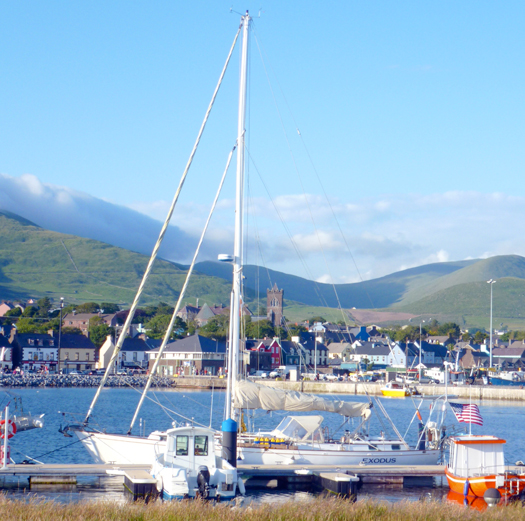
There's a small but significant "Transatlantic trade". The American cutter Exodus was welcomed to Dingle Photo: W M Nixon
The fact of having to round Land's End to get to Ireland for this latter group makes for two distinct visitor streams sailing to this country. The configuration of Ireland's south coast means that any boat rounding Land's End is virtually equidistant from all ports between West Cork and Wexford. With the prevailing winds from the southwest, and the most popular cruising grounds to be found in southwest Ireland, this southern stream will try to make westing as much as possible, preferably to West Cork and certainly no further east than Cork Harbour. They will only shape their course in a more easterly direction if they intend to go northwards through the Irish Sea.
The Bristol Channel makes for the great divide, as most boats in the area are berthed along its north shore, on the south coast of Wales and in Milford Haven. Thus they are part of the other visitor stream. If heading for Ireland, they'll almost invariably make their landfall in south Wexford, and so they will share the needs of people from all ports in the Irish Sea for a better selection of facilities in southeast Ireland, which is the greatest single problem facing the overall development of Ireland's cruising product.
Why is the lack of a good selection of harbours in southeast Ireland such a problem?
There's a large and increasing boat population on both sides of the Irish Sea, and they're keen to go further. While their own area is improving as a cruising ground in its own right, many more of these boats would be attracted to the idea of cruising to Ireland's south and southwest coasts if there were more and better harbours along the coasts in those challenging waters all the way from Arklow to Dungarvan

The big-hearted little port. Despite its small size, Kilmore Quay manages to provide proper berthing for cruisers and a very active fishing fleet.
Photo: W M Nixon
It says everything about the limited facilities in all of southeast Ireland that the provision of a modest marina at Kimore Quay has been the greatest single cruising improvement in the region in fifty years. Kilmore Quay is excellent in its way, it's strategically useful, and is known for the warmth of its welcome. But because it is isolated on an exposed and difficult bit of coast, if you're caught out there in bad weather you've no options for even the most limited movement in reasonably sheltered waters – you just have to stay put and stick it out, or else leave your boat in Kilmore's shelter, and simply go home until the weather improves
By contrast, Dunmore East at the entrance to Waterford Estuary has marvellous natural advantages. Even if the weather is too extreme for offshore passages, there's plenty of sheltered cruising to be had up to Waterford and New Ross, with marinas at both places, while other anchorages are available in attractive surroundings.
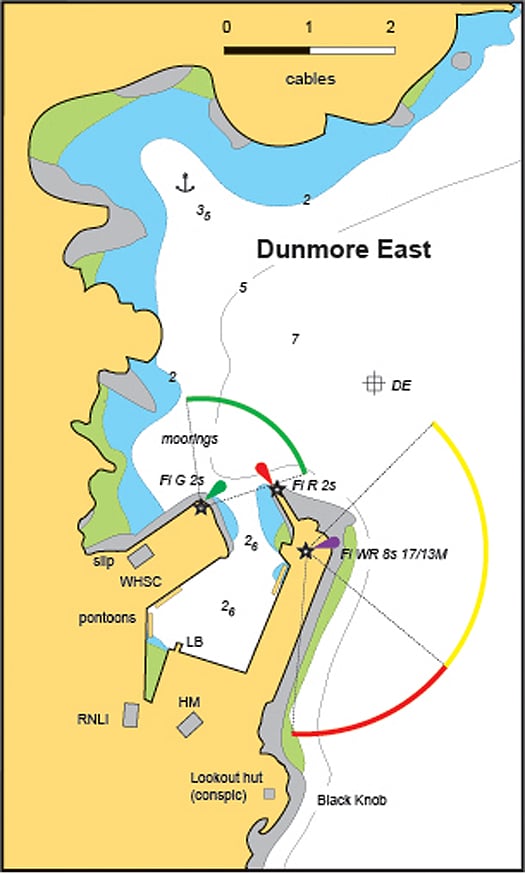
Crowded boats in Dunmore East, which has discouraged cruisers in times past.
Yet despite the friendly Waterford Harbour Sailing Club there doing the best it can in difficult circumstances, the fisheries harbour at Dunmore East has long been noted as actively hostile to cruising boats. It has been a coastal hospitality blackspot on the entire area. The word is that some minor gestures of improvement may be on the way, but as it is, it's difficult to see why it has deteriorated so much, and why positive steps haven't been taken much sooner.
Perhaps it's something to do with the fact that Waterford County Council is headquartered at Dungarvan in the west of the county, while just up the road in the northeast is the all-powerful and historic Waterford City Corporation. Whatever it is, Dunmore East harbour seems to be an administrative orphan. Yet it could be redeemed by being re-invigorated as a fishing port with a significant sailing presence.

Mallaig on Scotland's West Coast used to be a byword for congested and conflicted berthing, but now with a small marina it accommodates cruising boats, fishing boats, a ferry port – and a boatyard too. Photo: W M Nixon
You only have to look at Dingle or Howth to realise that such a thing is perfectly possible. But if the powers that be from the southeast don't want to be seen going to other Irish harbours to see how Dunmore East might be re-born, then let them go to Mallaig on the west coast of Scotland. It used to be a byword for bad tempers, as fishing boats, ferries and cruising yachts battled for space. But now all is sweetness and light with the layout rationalized, and the cruising boats provided with their own neat little 50-berth marina which has made the place not merely somewhere you call by to implement crew changes using the famous west Highland Railway, but an attractive destination in its own right.
So we'll be very interested to see what "A Review of Tourism Policy Regarding the Development and Funding of Marina and Berthing Facilities in Ireland" has to say about Dunmore East. There are times you'd be thinking it's the magic key to the whole thing.
ECHOES OF THE REPUBLIC UP NORTH
Intriguing to see that the Royal Yachting Association's new National Handicap System for cruisers is being launched at Ballyholme YC on Belfast Lough. Is it really so new? After all, most clubs have been getting by with the up-graded Portsmouth Yardstick system for a very long time. And as well, just across the North Channel, the Clyde Yacht Clubs Handicap has been catering for different cruisers for years, and most Belfast Lough boats have been able to avail of that.
But then, things have always been a bit different on Belfast Lough. Back in the late 19th Century, it was a hotbed of pure One Design development, so maybe that tradition has something to do with the lack of a viable local cruiser handicapping system. And by heavens, when they said One Design For Level Racing, they meant it. Having been reared with Belfast Lough sailing, when I first sailed with an alleged One Design class in Dublin, I was amazed to find they ran two sets of results – scratch and handicap. Within the overall class programme, the competition for the handicap prizes was in its way every bit as intense as the straight one design racing.
Thus most boats got a look-in at the prize giving, but in Belfast Lough some never figured at all. Their mood was set by unflinching Calvinists. So in the rare event that one of their One Design fleets ever got above a dozen boats, they'd no hesitation in making the next one Number 13. They wouldn't have dreamt of that in Dublin, where Number 13 simply didn't exist. But I had my very first race aboard the Belfast Lough Waverley Class 18ft Montrose, jointly owned by my father and uncle. And Montrose was Number 13. There are those who would suggest this has affected my life ever since, but they're wrong – touch wood.
Be that as it may, regarding the RYA's claim to novelty for its NHS (I'm sure that won't be the final acronym, with the problems the National Health Service is having across the water these days), at least Mike Urwin of the RORC Measurement Office has made the point that in Ireland we've had a very successful "sundry boats" handicap system running for many years in parallel with the IRC (and the Channel Handicap and the IOR before that), our good and trusty old friend the ECHO system.

The Great ECHO Mother. The unusual lines of the George McGruer-designed 42ft Tritsch-Tratsch, provider of the performance benchmark which facilitated the creation of ECHO back in the early 1970s
It goes right back to 1971, when the late Bill Lacy began to develop a poor man's IOR at Howth by rating local boats on their performance against Otto Glaser's 42ft George McGruer-designed Admirals Cupper Tritsch-Tratsch I. Tritsch Tratsch, a remarkable varnished sloop, was very under-canvassed by today's standards, but a wizard to windward as she had a unique hull based on 12 Metre thinking. Despite her small rig, she could out-sail everything in the area (and elsewhere as well), so she was an excellent benchmark from which the system developed, with Billy working along with Chick Brown, another Howth sailor of mathematical inclinations.
Across in Dun Laoghaire, Hal Sisk and Ernest Goulding had been working on something similar, and an area handicap system developed so successfully that it was given the grand title of East Coast Handicap Organisation, though those involved readily admitted that if anything, ECHO stood for Ernest, Chick, Hal and Others.
Whatever, it worked, rating crews and helms as much as boats. It was a system which was readily accepted in an area where One Design Classes readily allocated different performance figures, and in a country where the Golfing Union of Ireland had led the world in handicapping individual players. As for those of us who felt our modest successes had been allowed to raise our handicaps too much, we could always take our boats and get them weighed and measured for a rating from the more impersonal Channel Handicap System.
So now, 42 years after Bill Lacy and his friends started their ground-breaking system, they're hearing about something similar up north. One trusts that they're aware that not only is today the 13th of the month, but we're also in the year of superstition 2013.
As for Tritsch-Tratsch the Great Echo Mother, the last I heard of her she was in Maine, with an owner who cherishes slightly eccentric classic boats. She is that and more. But what a performer to windward.....back in 1972 she was slugging upwind on a very windy but sunny Sunday morning out in the middle of the Irish Sea, rocketing along and making mincemeat of the steep breaking seas in an ISORA race, with the rest of the fleet way behind.
A big ship hove into view, and paced along beside her, both of them covered in spray and spume, and the noise intense. Suddenly, it occurred to TT's crew that the ship might think they needed help. So they called her on the VHF, and told them on the bridge that everything was okay. Their reply would have gladdened any owner's heart:
"We can see that," said the ship. "But it's just that your boat is going great. Absolutely marvellous. D'you mind if we watch for a while?"
































